Cryptoevent.io is your trusted guide and assistant to the world of Cryptocurrency. With all the latest news, professional reviews, leading tools and up-to-date information, we create for you a one-stop-shop. We do the work for you so that you don't have to! Follow Us! Youtube Channel Blogger WordPress Twitter About.me
Don't wanna be here? Send us removal request.
Text
BTC, ETH, ADA, BNB, XRP, DOGE, SOL, DOT, UNI, LUNA
There’s an old saying that history doesn’t keep repeating itself, but it does tend to rhyme. If this is the case for Bitcoin (BTC), there may not be a sharp move higher in September.
Bybit data shows that Bitcoin has closed September in the red for six years since 2013 and only hit positive monthly closings twice. The best performance was in 2016 when Bitcoin rose 6.04%.
Daily performance of the cryptocurrency market. Source: Coin360
However, the poor historical performance in September didn’t stop small and large traders from amassing Bitcoin in August. Ecoinometrics reported rising account balances for addresses with 1,000-10,000 BTC and for accounts with less than one bitcoin.
Will the cops be scared off by September’s bad historical record, or will this year be an exception? Let’s analyze the top 10 cryptocurrency charts to find out.
BTC / USDT
The bulls again failed to push the price above the overhead resistance of $ 50,000 on August 29, suggesting the bears are aggressively defending the level. Bitcoin formed a doji candlestick pattern on Aug 29, which has resolved to the downside today.
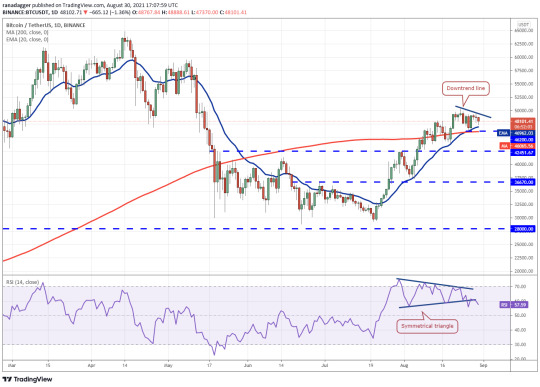
BTC / USDT daily chart. Source: TradingView
The failure of the relative strength index (RSI) to climb back into the symmetrical triangle indicates weakness. If bears pull the price below the 200-day simple moving average ($ 46,065), the BTC / USDT pair could fall to the nearest support at $ 42,451.67.
This level should serve as strong support. If the price rebounds from these levels, the pair can stay in a range between $ 42,451.67 and $ 50,500 for a few days.
A break and close below $ 42,451.67 signals the beginning of a deeper correction. The pair could then correct to $ 36,670.
This negative view will be invalidated if the price starts from the current level and breaks above $ 50,500. Such a move could open the gates for a rally to $ 60,000.
ETH / USDT
Ether (ETH) fell again from the overhead resistance zone at $ 3,335 to $ 3,377.89 on August 29. This suggests that the bears are aggressively defending the overhead zone.
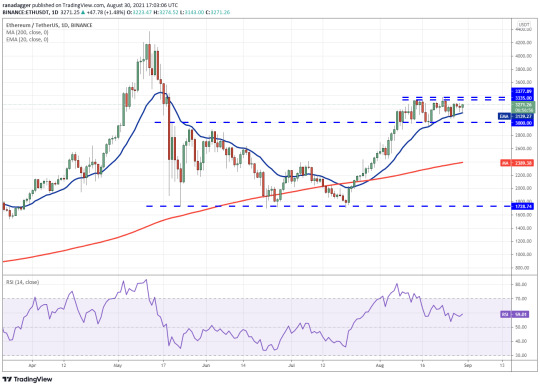
ETH / USDT daily chart. Source: TradingView
The bulls have not given up, however, and are defending the 20-day exponential moving average ($ 3,139) as evidenced by today’s strong rebound. If the bulls push the price above the overhead zone, the ETH / USDT pair could continue its bullish move with a target of $ 3,670 then $ 4,000.
On the flip side, if bears pull the price below the 20-day EMA, the ETH / USDT pair could fall to the breakout level at $ 3,000. A rebound from this level could hold the pair in a range between $ 3,000 and $ 3,377.89 for a few more days.
A deeper correction could begin if the bears pull and hold the price below the $ 3,000 breakout level. This could cause a fall to the 200-day SMA ($ 2,389).
ADA / USDT
Cardano (ADA) moved down from $ 2.95 on Aug 28, suggesting the bears are aggressively defending overhead resistance at $ 2.97. This was followed by a doji candlestick pattern on Aug 29, indicating indecision between bulls and bears.

ADA / USDT daily chart. Source: TradingView
Uncertainty has widened today with the formation of the inside-day candlestick pattern. If sellers let the ADA / USDT pair dip below the August 29 intraday low at $ 2.71, the pair could fall back to the breakout level at $ 2.47. A strong rebound from these levels could hold the pair in a range between $ 2.47 and $ 2.97 for a few days.
While the rising 20-day EMA ($ 2.44) may suggest an advantage to buyers, the negative divergence on the RSI suggests the momentum is easing. A breakout and close below $ 2.47 indicates the beginning of a deeper correction. The pair can then drop to $ 2.20.
The bulls need to push and hold the price above the psychological level of $ 3 to signal the resumption of the uptrend.
BNB / USDT
The bulls’ failure to get Binance Coin (BNB) above the 19 intraday high. The altcoin has declined and could now fall to the breakout level at $ 433.
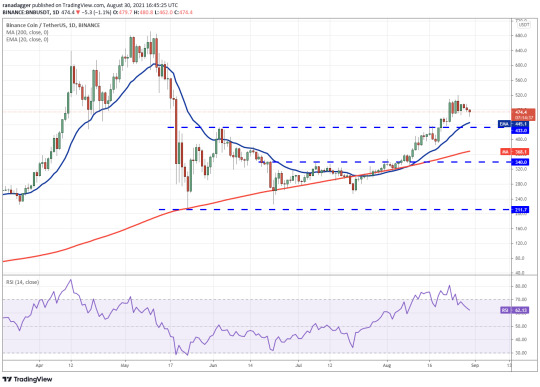
BNB / USDT daily chart. Source: TradingView
The bulls are likely to aggressively defend the support zone between the 20-day EMA ($ 445) and the breakout level at $ 433. A strong rebound out of this zone will suggest sentiment remain positive and bulls will buy on dips.
A breakout and close above USD 520 signals the resumption of the uptrend. The BNB / USDT pair could then rise to $ 600. Conversely, the pair could fall to the 200-day SMA ($ 368) if bears push the price below $ 433.
XRP / USDT
XRP rebounded from the USD 1.07 support on August 27, but the bulls were unable to push the price onto the downtrend line. This suggests that demand is drying up at higher levels. The bears are currently trying to lower the price to the critical support at $ 1.07.
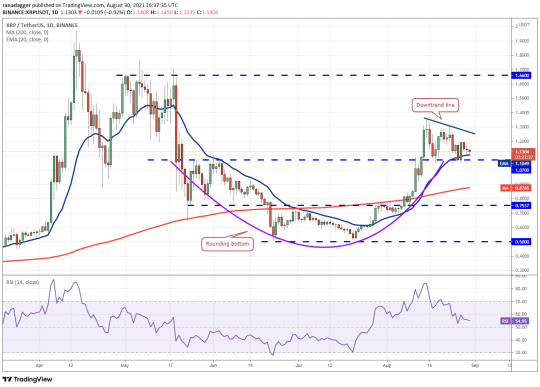
XRP / USDT daily chart. Source: TradingView
The price action of the past few days has formed a descending triangle pattern that completes on a breakout and closes below $ 1.05. This setup has a target target of $ 0.75. The flattening 20-day EMA (1.10) and the RSI near the middle suggest that the bulls are losing their hold.
Conversely, if price bounces off the USD 1.05 support and breaks above the downtrend line, the bearish set-up will be undone. Failure of a bearish pattern is a bullish sign. The pair could then begin its rally to $ 1.35, followed by a surge to $ 1.66.
DOGE / USDT
Dogecoin (DOGE) rose above the overhead resistance at $ 0.29 on August 27, but the bulls were unable to hold the higher levels. The price fell back below $ 0.29 on August 28.
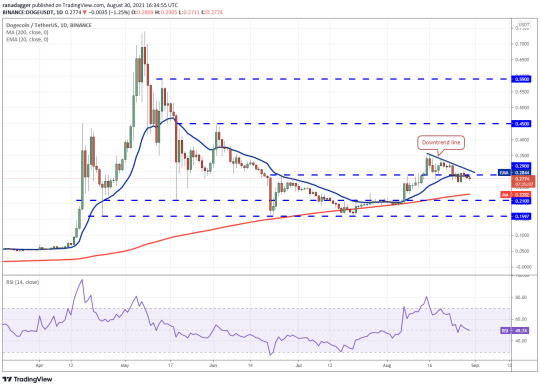
DOGE / USDT daily chart. Source: TradingView
The bears will now seek to break the price below the immediate support at $ 0.26. If they succeed, the DOGE / USDT pair could fall to the critical support at $ 0.21.
The flat 20-day EMA ($ 0.28) and the RSI near the middle suggest a balance between supply and demand.
This equilibrium will shift in favor of the bulls if they can push and hold the price above the downtrend line. The pair could then rise to $ 0.35 and later to $ 0.45.
SOL / USDT
Solana (SOL) is on a strong uptrend. The move up stopped on August 29, but the long tail on the day’s candlestick showed that the bulls bought on drops. Buyers have pushed the price to a new all-time high again today.

SOL / USDT daily chart. Source: TradingView
If the bulls keep the price above $ 100, the SOL / USDT pair could begin its journey towards the next target at $ 122.09. While momentum is strong, the RSI above 83 suggests the rally is overheating in the short term.
The first sign of weakness will be a breakout and a close below $ 90. This suggests that traders are aggressively posting profits. The pair could then correct to the 20-day EMA (USD 72) which is likely to act as strong support. A break and a close below this support signal a possible turnaround.
DOT / USDT
The uptrend line in Polkadot (DOT) acts as resistance. Attempts by the bulls to push the price back above this line failed on August 27th and 28th, suggesting traders may close their positions on rallies.
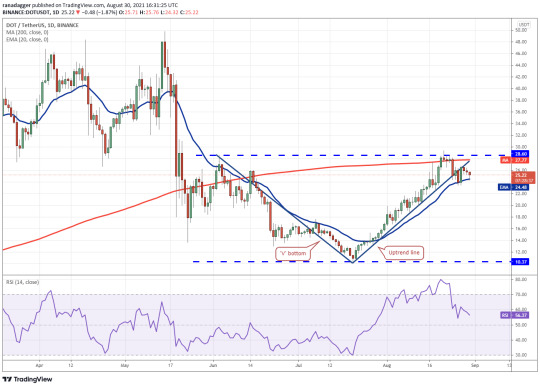
DOT / USDT daily chart. Source: TradingView
If bears pull price below the 20-day EMA ($ 24.48), the DOT / USDT pair could see further selling. The pair could then fall to the strong support at $ 18. Such a move will suggest that the pair could extend their range action for a few days.
The gradually flattening 20-day EMA and the RSI just above the middle suggest that the bulls are losing their hold. To get the upper hand, the bulls will need to push and hold the price above $ 28.60. This will complete a V-bottom pattern that has a target at $ 46.83.
Related: This service declares that it is again the “crypto-old season”
UNI / USDT
Uniswap (UNI) bounced off the $ 25 support on August 27 and rose above the moving averages, but the bulls were unable to hold the higher levels. This suggests that the bears have not given up and are selling on rallies.

UNI / USDT daily chart. Source: TradingView
The price has fallen back below the moving averages today and sellers will now try to pull the price below the $ 25 support. In this case, the UNI / USDT pair will complete a small descending triangle pattern. This bearish setup has a target target of $ 18.74.
Alternatively, if price bounces off the $ 25 support and breaks above the downtrend line, the bearish setup will be invalidated. The pair could then climb to $ 30. The bulls need to push and hold the price above this resistance to signal the start of a new uptrend.
MOON / USDT
Terra Protocol’s LUNA rebounded to a new all-time high on August 29, but traders took advantage of the surge to post profits. The price moved lower today but rebounded significantly from $ 32, suggesting that the bulls had flipped previous resistance into support.

LUNA / USDT daily chart. Source: TradingView
Buyers will now try to push the price above the all-time high of $ 36.89. If they do that, the LUNA / USDT pair could begin its journey to the next destination at $ 43 and later at $ 50.
Contrary to this assumption, the bears will attempt to lower the pair to the 20-day EMA ($ 27.23) if the price drops again from $ 36.89.
A strong rebound from this support will suggest sentiment remains positive and traders buy on dips. The bulls will then try again to continue the upward move. The bears will need to pull and hold below the 20-day EMA to weaken bullish momentum.
The views and opinions expressed are those of the author only and do not necessarily reflect the views of Cointelegraph. Every investment and trading movement carries risks. You should do your own research when making a decision.
Market data is provided by HitBTC Exchange.
0 notes
Text
U.S. Congress submits 18 crypto bills in 2021, Visa buys $150K CryptoPunk, MicroStrategy snaps up more BTC: Hodler’s Digest, Aug. 22-28
Hodler’s Digest comes every Saturday and helps you keep track of every single important message that happened this week. The best (and worst) quotes, introductory and regulatory highlights, leading coins, predictions, and more – one week on Cointelegraph in one link.
This week’s top stories
Congress has tabled 18 digital asset bills so far in 2021
The U.S. Congress has stepped up its efforts to create a regulatory framework for crypto in 2021, tipping 18 bills on digital assets and blockchain technology so far this year.
According to an August 22 analysis by former Federal Deposit Insurance Corporation regulator Jason Brett, the current 117th Congress differs from its predecessor in that it has focused on regulating decentralized assets as opposed to private stablecoins.
This week it was also reported that the controversial $ 1 trillion infrastructure bill will be voted in the House of Representatives until September 27th – without changes to the controversial crypto tax regulations.
Visa invests $ 150,000 in NFT CryptoPunk asset
This week, Visa, Visa spent $ 150,000 on a tokenized JPEG of a pixel art punk, better known as CryptoPunk-NFT. The Company announced the news in a blog post on Aug. 23 teasing Cuy Sheffield, head of the crypto division at Visa, that the company may be considering an extended stint in the industry.
“To help our customers and partners participate, we need to understand firsthand the infrastructure requirements of a global brand to buy, store, and use an NFT,” he said.
Visa bought CryptoPunk 7610 – a female figure with a mohawk, green clown make-up eyes and lipstick. “Understanding the infrastructure requirements” when buying an NFT didn’t have to take long, all you have to do is buy it and keep it in your wallet. This is not rocket science.
also Budweiser participated in the action by buying a Fan Art NFT for 8 ethers (ETH) worth around $ 25,000. The NFT depicted a Budweiser branded rocket that took five minutes to launch on Adobe Illustrator. The beer maker also spent 30 ETH, or $ 94,000 on the Beer.eth domain name through the Ethereum Name Service on OpenSea.
PayPal introduces crypto services for UK customers
Global payments provider PayPal announced this week the launch of its crypto services for customers in the UK.
PayPal first launched its crypto services less than a year ago, and this is the first time it has expanded crypto support beyond the US shores.
The company will initially enable customers to acquire crypto assets including Bitcoin (BTC), Ether, Litecoin (LTC) and Bitcoin Cash (BCH). However, crypto transactions for PayPal business accounts are not yet supported.
MicroStrategy splashes $ 177 million on Bitcoin, now holding nearly 109,000 BTC
MicroStrategy, led by Bitcoin Apostle Michael Saylor, has looted additional digital gold worth $ 177 million. The latest purchase brings the company’s balance sheet to 108,992 BTC, which cost a total of just $ 2,918 billion.
The average purchase price for its BTC is around $ 26,769 per coin. Since the price of BTC was $ 47,584 at the time of writing, MicroStrategy is valued at $ 5.1 billion.
It’s a foregone conclusion that Saylor is “all-in” with BTC at this point. However, it remains to be seen whether he will respond to crypto skeptics Peter Schiff’s call for debate. Schiff competed against Anthony Scaramucci this week to see if gold or BTC would be a better store of value. After winning, he jokingly said:
“I just have to say one thing: Michael Saylor, stop ducking me, I know you’re out there.”
Binance denies allegations of market manipulation
Major crypto exchange Binance hit the market this week as it defended itself against allegations of market manipulation and trading against its users.
The company is currently facing regulatory scrutiny, and in an Aug. 23 thread on Twitter, Binance appeared to be blamed for allegations of market manipulation on publications disseminating FUD as well as those posing as Binance employees.
The company said that while it worked on its compliance goals with regulators, it was expecting “fewer FUD dealers and malevolent people” and continued to warn:
“Binance reserves the right to take legal action to protect your interests and welcomes responsible whistleblowing that protects the trust of our community.”
Winner and Loser
At the end of the week, Bitcoin is at $ 48,373, Ether at $ 3,233 and XRP at $ 1.14. The total market capitalization is $ 2.08 trillion, according to to CoinMarketCap.
Among the top 100 cryptocurrencies, the top three altcoin winners of the week are Tezos (XTZ) at 46.33%, avalanche (AVAX) at 33.86% and Celo (FOREHEAD) at 31.97%.
The three biggest altcoin losers of the week are Audius (AUDIO) at -21.08%, XinFin network (XDC) at -13.99% and SushiSwap (SUSHI) at -12.76%.
For more information on crypto pricing, be sure to read Market analysis by Cointelegraph.
The most memorable quotes
“As long as the law says that software developers, miners and stakers must do the impossible, there is no lawyer who would advise them to break laws whose penalties for non-compliance would easily ruin them.”
Lawrence Zlatkin, Coinbase Global Vice President of Tax
“Over the past year we have seen a significant change in the way the global financial ecosystem thinks about new business models powered by digital assets and how this plays a significant role in financial infrastructure.”
Linda Pawczuk, Principal at Deloitte Consulting
“We’ll want to wait for all regulatory things. Of course, crypto is an extremely interesting area that is the biggest buzzword and is doing exceptionally well. But we would like to understand more on the regulatory side. “
Manu Jain, CEO of Xiaomi India
“A trading platform that offers US persons derivatives on digital assets without registering or violating the CFTC’s trading rules is subject to the CFTC’s enforcement agency.”
Dawn Stump, Commissioner for the US Commodity Futures Trading Commission
“If you have a good crypto wallet like Novi, you also need to think about how you can help consumers support NFTs.”
David Marcus, head of Facebook Financial and co-founder of Diem
“Be wary of low risk, high return investments. If something sounds too good to be true, it probably is too. “
Delia Rickard, Vice Chair of the Australian Competition and Consumer Commission
“Binance has never acted against our users or manipulated the market, and neither will we.”
Binance
“With our CryptoPunk purchase, we will jump into our feet first. This is just the beginning of our work in this area. “
Cuy Sheffield, head of crypto at Visa
“I think this cryptocurrency revolution and Bitcoin in particular will surpass gold due to its scarcity. It’s more portable, it’s impregnable in terms of transaction over the blockchain […] and it’s accepted pretty quickly. “
Anthony Scaramucci, Skybridge founder
Forecast of the week
The bullish bitcoin cross on the weekly chart draws a BTC price target of $ 225,000 if history repeats itself
Bitcoin hit the $ 50,000 level again this week, although the asset subsequently fell several thousand dollars on a price correction and hovered between $ 45,000 and $ 50,000 for most of the week.
During the month of August, the Moving Average Convergence / Divergence (MACD) indicator formed on the weekly price chart of Bitcoin and continued by a cross of the two lines of the indicator and jumped to green on its histogram (the part of the bar at the bottom of the indicator).
What does it mean? Well, nothing is certain, but according to reports from Cointelegraph’s William Suberg, when Bitcoin’s MACD indicator last performed similarly (last fall), the asset’s price rose more than five-fold in value over the next half-dozen months. According to Suberg, BTC could potentially soar above $ 200,000 if things turn out on a comparable basis.
FUD of the week
Google bans 8 “fraudulent” crypto apps from the Play Store
Google, the Silicon Valley-based tech overlord, removed eight fraudulent crypto apps from its Google Play store this week.
Fraudulent crypto-themed mobile apps have surfaced more frequently in the past 12 months and usually operate under the false pretext of offering cloud mining services.
According to a recent report from Trend Micro, the apps were charging around $ 15 a month for their fake services plus “increased mining skills” – all while getting users to watch paid ads.
Allegedly fake crypto apps included mining services like BitFunds, Bitcoin Miner, Daily Bitcoin Rewards, Crypto Holic, and MineBit Pro, to name a few.
Poll shows Britons concerned about the prospect of a digital pound
According to a survey conducted by Redfield & Wilton Strategies on behalf of Politico, 30% of UK adults have concerns about a Central Bank Digital Currency (CBDC) issued by the Bank of England.
For some reason, the idea of having a programmable, government-sponsored CBDC that can track all of their spending habits doesn’t sound appealing to them. If you think that’s bad, just wait until you hear about the insatiable appetite for personal data from Apple, Google, or Facebook.
In early August, 2,500 British adults were interviewed in the study, with 24% believing it could be beneficial, while 46% were undecided.
Coinbase users are mad at customer support after funds disappear from accounts
The leading U.S. crypto exchange Coinbase faced a backlash this week over terrible customer service regarding users reporting hacks and withdrawing funds.
According to a CNBC investigation on Aug. 24, thousands of disgruntled customers in the US have filed complaints against the company and are unhappy with Coinbase’s lack of response in handling hacks and stolen funds.
“Interviews with Coinbase customers across the country and a review out of thousands of complaints show a pattern of account takeovers where users suddenly see money disappearing from their account, followed by poor customer service from Coinbase which left these users hanging and feeling angry, “CNBC said.
Best Cointelegraph Features
Blockchain is as revolutionary as electricity: Big ideas with Jason Potts
“This is the end revolution that started with the internet. “
London’s Influence: The Ethereum 2.0 staking contract becomes the largest ETH holder
The aftermath of the London upgrade begins to emerge as the Eth2 staking contract becomes the largest Ether holder.
The new episode of crypto regulation: The Empire Strikes Back
A decentralized stock exchange billing is coming – and it is bigger than the infrastructure billing – so the DeFi community has to be ready.
0 notes
Text
BTC, ETH, ADA, BNB, XRP, DOGE, DOT, SOL, UNI, LUNA
According to Buy Bitcoin Worldwide, asset managers and companies currently hold over 6% of the circulating supply of Bitcoin (BTC). A breakdown of the data shows that bitcoin fund issuers and asset managers hold about 4% of the supply of bitcoin, public corporations hold almost 1%, and private companies hold about 0.83% of the supply of cryptocurrency.
It’s clear that institutional investors have continued to add crypto to their portfolios, and Adam Proctor, the executive director of billionaire Simon Nixon’s investment firm Seek Ventures, said the company plans to increase the “allocation to crypto” as they do it for you “Important area” hold for the future. “
Daily performance of the cryptocurrency market. Source: Coin360
CNBC Mad Money host Jim Cramer recently said he was a “believer in crypto” and recommended that investors put 5% of their investment portfolio in digital currencies.
Will Bitcoin break the psychological barrier of $ 50,000, causing a rush to buy in the industry? Let’s check out the top 10 cryptocurrency charts to find out.
BTC / USDT
Strong resistance near the $ 50,000 mark could have led to profit posting from short-term traders on Aug 26. This pulled Bitcoin below the support line of the rising wedge pattern, but the bears were unable to capitalize on this move and the price below the moving average.
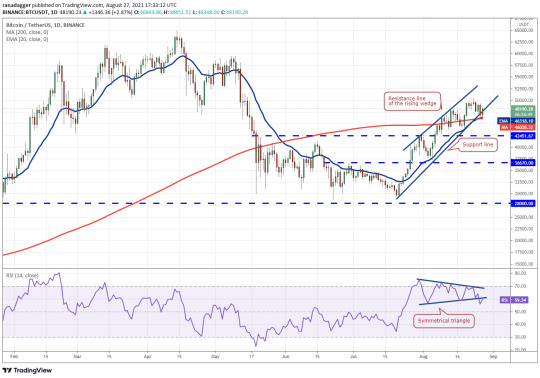
BTC / USDT daily chart. Source: TradingView
The bulls pushed the price back into the wedge today. If the rebound continues, the BTC / USDT pair could gradually move towards the overhead resistance zone of $ 50,000 to $ 50,500. A breakout and close above this zone indicate the resumption of the uptrend.
The pair could then climb to the resistance line of the wedge, where bears could build up stiff resistance again. If the price deviates from this resistance, the pair may continue to rise within the wedge.
A break in the wedge signals an increase in momentum. That could rally to $ 60,000.
The relative strength index (RSI) has fallen below a symmetrical triangle pattern, indicating a marginal advantage for the bears. If the price drops from current levels and falls below the moving averages, the pair can drop to $ 42,451.67.
ETH / USDT
Ether (ETH) has consolidated in a tight range between $ 3,000 and $ 3,335 for the past few days. The 20-day exponential moving average ($ 3.097) is flattening out and the RSI is just above the middle, suggesting an equilibrium between supply and demand.

ETH / USDT daily chart. Source: TradingView
The price bounced back from the 20-day EMA today and the bulls will now try to push the price above $ 3,335. When that happens, it suggests that the bulls have amassed the ETH / USDT pair within the range. The pair could then rise to $ 3,670 and later to $ 4,000.
A breakout and a close below $ 3,000 suggests the bears have overpowered the bulls. This could lead to further selling as multiple stop losses can be hit. The pair could then fall to the nearest support at the 200-day simple moving average ($ 2,366).
ADA / USDT
Generally, the outbreak is retested from a critical level, as shown in Cardano (ADA). The price fell from an all-time high of $ 2.97 on Aug 23 to the breakout level of $ 2.47 on Aug 26.

ADA / USDT daily chart. Source: TradingView
The ADA / USDT pair rebounded from $ 2.47 today, suggesting sentiment remains positive and traders buy on every small decline. The bulls will make another attempt to push the price above the overhead resistance at $ 2.97.
If successful, the pair could rise to $ 3.50. The rising 20-day EMA ($ 2.29) and the RSI in the overbought territory suggest an advantage for buyers.
Conversely, if the price drops from current levels or from overhead resistance, it indicates that the bulls are closing their positions on rallies. A break and close below the 20-day EMA signal the beginning of a deeper correction.
BNB / USDT
Binance Coin’s (BNB) intraday high on May 19 was $ 516.50 and that level should act as a strong resistance. The bulls pushed the price above this resistance on August 26, but failed to hold the altcoin above it.

BNB / USDT daily chart. Source: TradingView
If buyers don’t give in much from current levels, it will indicate strength. The cops will then make one more attempt to overcome the overhead hurdle. If they do, the BNB / USDT pair could rise to $ 600.
The rising 20-day EMA ($ 432) and the RSI in positive territory suggest an advantage for buyers. This positive view will be invalidated if the price goes down and falls below the 20-day EMA. This could lead to a decline to the 200-day SMA ($ 362).
XRP / USDT
XRP has again fallen to the breakout level at $ 1.07. This is an important level for the bulls to defend because if it cracks the altcoin could see a long liquidation and fall to the nearest support at the 200-day SMA ($ 0.86).
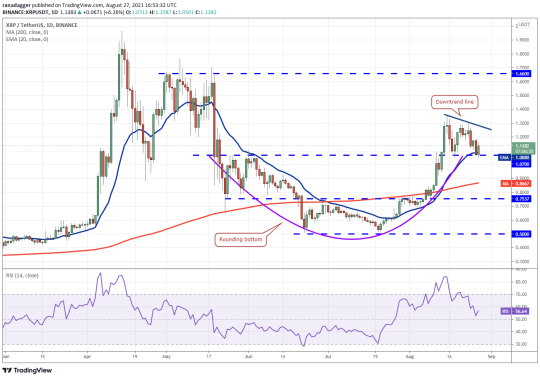
XRP / USDT daily chart. Source: TradingView
The flattening 20-day EMA ($ 1.08) and the RSI just above the middle suggest that the bulls may be losing control.
If the price recovers from current levels, the XRP / USDT pair could climb onto the downtrend line. A breakout and close above the downtrendline increases the likelihood of a rally to the overhead resistance at $ 1.66.
On the other hand, if the price starts to deviate from the downtrendline again, the pair may be at greater risk of initiating a deeper correction.
DOGE / USDT
Dogecoin (DOGE) fell below the 20-day EMA ($ 0.28) on Aug 27, suggesting that supply is outstripping demand. The bulls are currently trying to push the price back above the overhead resistance at $ 0.29.

DOGE / USDT daily chart. Source: TradingView
If the DOGE / USDT pair breaks the downtrendline, bullish momentum could increase. The pair could then rise to $ 0.35 and if that level is exceeded the next move could lead to overhead resistance at $ 0.45.
On the contrary, if the price is pulling down from current levels, it suggests that the bears are aggressively defending at $ 0.29. The pair could then fall to $ 0.21. A strong rebound from this support could hold the pair between $ 0.21 and $ 0.29 for a few days.
DOT / USDT
Polkadot (DOT) moved down from the overhead resistance at $ 28.60 and corrected to the 20-day EMA ($ 24.03). The strong rebound from this level shows that bulls pile up on dips.
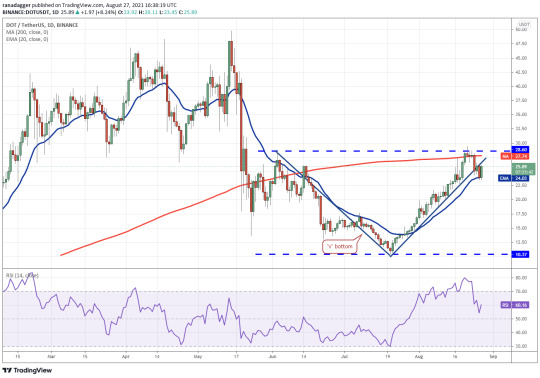
DOT / USDT daily chart. Source: TradingView
If the rally continues, the bulls will attempt to push the price above the overhead resistance at $ 28.60. If the DOT / USDT pair holds above $ 28.60 it will complete a v-bottom which is targeted at $ 46.83.
Alternatively, if the rally fizzles out, the bears will seek to bring the price below the 20-day EMA. If so, the pair could fall to the next strong support at $ 18. If the price rebounds from these levels, the pair can stay in a range of $ 18-28.60 for a few days.
SOL / USDT
The long tail of the Solana (SOL) candle on August 25th and 26th shows strong buying at lower levels. A shallow correction after a sharp move higher is a sign of strength as it suggests that traders are not closing their positions and buying on small drops.

SOL / USDT daily chart. Source: TradingView
The bulls pushed the price above the all-time high of $ 82 today. If buyers hold the price above $ 82, the SOL / USDT pair could begin its journey towards the next psychological barrier at $ 100.
The rising 20-day EMA ($ 63) and the RSI in the overbought territory suggest that the bulls are in control. If the price fails to hold above $ 82, the pair could remain in a range for a few days. The bears will need to pull the price below $ 58.38 to break bullish momentum.
Related: Bitcoin could hit $ 30,000 or $ 100,000 this year as analysts warn that “the next few months are key”
UNI / USDT
Uniswap (UNI) fell below the moving averages on August 24th, indicating weakness. The bulls attempted to push the price back above the moving averages on August 25th and 26th, but were unable to hold the higher levels.
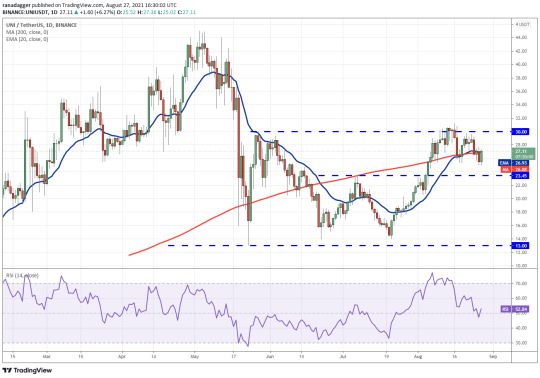
UNI / USDT daily chart. Source: TradingView
The bulls are currently trying again to push price above the moving averages. If they do that, the UNI / USDT pair could rise to $ 30. A break out of the overhead resistance zone of $ 30- $ 31.25 could signal the start of a new uptrend.
Conversely, the UNI / USDT pair could fall to the critical support at USD 23.45 if the price deviates from the moving averages. A strong rebound from this level could hold the pair between $ 23.45 and $ 30 for the short term. The flat moving averages and the RSI near the middle also suggest a consolidation for a few days.
MOON / USDT
The Terra Protocol’s LUNA token has consolidated between $ 26 and $ 32 in the past few days. Although the bulls pushed the price above $ 32 on August 19th and 24th, they were unable to sustain the higher levels.

LUNA / USDT daily chart. Source: TradingView
The LUNA / USDT pair bounced back from support today and the bulls will try again to continue the uptrend. If the price closes above the $ 32 to $ 34.67 resistance zone, the pair could rise to $ 43.
The rising 20-day EMA ($ 24.44) and the RSI in the overbought territory suggest that the path of least resistance is on the upside. This bullish view will be dashed if the price drops from current levels or overhead resistance and drops below the breakout level at $ 22.40.
The views and opinions expressed are those of the author only and do not necessarily reflect the views of Cointelegraph. Every investment and trading movement carries risks. You should do your own research when making a decision.
Market data is provided by HitBTC Exchange.
0 notes
Text
Ready Player Cats DAO, surging NFT interest, court rules crypto is not property – Cointelegraph Magazine
This weekly roundup of news from mainland China, Taiwan, and Hong Kong attempts to curate the industry’s top news, including influential projects, changes in the regulatory landscape, and corporate blockchain integrations.
After the global KYC requirements were enforced for all users, Binance’s dominance in CeFi has dropped from about two-thirds to just over half, according to the FTX volume monitor. The big three from Huobi, Binance and OKEx now look like a big five, with Hong Kong-based FTX and Singapore-based Bybit filling the gap.
The global NFT fever seems to be intensifying in a week that Visa hit the headlines $ 150,000 purchase by CryptoPunk 7610. Chinese internet users on Weibo were unsurprisingly baffled, with comments asking what can be done with it after purchase while others were doing it Jokes about whether a punk had artistic value or not. Since the end of June, daily searches for “NFT” have been between 2.5 million and 4 million, which shows a growing interest in the asset class.
Related: Shanghai Special: Crypto Raid Fallout and What Happens Next
Bitcoin possession is not forbidden, but many fear for the future of regulations in China. Here you can see where we are and where we could go.
Meet the MAODAO
the MAODAO is one of the first NFT communities to emerge in Asia, with a current focus on China. It is based on play-to-earn gaming, with the DAO sponsoring players in the Axie Infinity world by providing assets upfront and then returning a portion of the proceeds to the DAO treasury. The DAO uses NFT cats, which are used as both collectibles and governance tokens. These Ready Player Cats, RPCs for short, are 3000 NFT cat tokens that were minted on August 22nd for 0.08 ETH. The colorful cartoon cats now have a price floor of almost 0.4 ETH.
The brightly colored cats sell for over $ 1,500 at OpenSea.
In conversation with founder Matt Mao, we learned that a lot of inspiration comes from another famous NFT project, the Bored Yacht Ape Club.
“Perhaps our most outstanding characteristic is our eastern roots. In fact, our first mint event was mostly run by early supporters from the Asian NFT and crypto community. Perhaps everyone’s enthusiasm came from the lack of a symbolic NFT project in the Eastern Church and gave us some appreciation. “
Mao plans to harness the abundant resources of the crypto community to grow and raise awareness in order to strengthen exchanges between western and eastern NFT communities. The outfit plans collaborations with other artists and projects to increase the rewards for the MAODAO and its members.
The organization shows off its Eastern heritage with vibrant colors and illustrations. Source: maonft.com
All’s well that ends well?
After a long and dramatic journey, the Poly is the Dramatic Network Hacker returned the rest of the funds to the cross-chain bridge. The hacker had exploited a bug in the code to lift Ethereum and other cryptocurrencies valued at over $ 610 million before taking the cryptocurrency space on a wild ride that included failed attempts to stave off a blacklist, raising money to Vitalik Buterin to send and to BUT via the blockchain. Poly Network, a project incubated by Neos O3 laboratories, will be delighted with funding from its users, although it remains to be seen whether the project can continue now that so much trust has been eroded.
Objection canceled!
A high court from northeastern Shandong Province set a precedent when it ruled that a plaintiff’s cryptocurrency had no legal status in China. The plaintiff in the case had lost around $ 10,000 worth of tokens after a 2017 ruling by the People’s Bank of China ordered exchanges to close. The plaintiff had lost access to his account and was hoping to get the value of the tokens back for fraud. It is not known whether the judge reminded the plaintiff at the end of the trial that it was “not your keys, not your cryptocurrency”.
This contradicts a ruling earlier this month in a Shanghai District Court ruling that Bitcoin was a property protected by Chinese law.
Shanghai Minhang District Court stated that Bitcoin is a virtual property protected by Chinese law that is disposable, interchangeable and exclusive. https://t.co/lUO3yr44Vw
– Wu Blockchain (@WuBlockchain) August 18, 2021
The lack of clarity and consensus on this issue is somewhat unusual for China, where top-down leadership can usually set clear directions. It is possible that, given the government’s focus on blockchain development, emerging technology, and the upcoming central bank digital currency, the government is hesitant to ban digital assets across the board.
Off to the west in the summer
Bitcoin and Ethereum miners appear to be completing their overseas migration after strict regulation was initiated against them earlier this summer. This is based on the fact that hash rate data recovered to around 66.7% of its pre-regulation peak in May. During the summer, most of the major mining companies closed their operations and shipped hardware to other countries, including Kazakhstan, Bangladesh, and the United States. This rebound means the mining industry and network as a whole have outgrown another major threat. Now that the network has moved away from such centralized centralization in China, it should become more attractive to risk-averse investors.
0 notes
Text
Price analysis 8/25: BTC, ETH, ADA, BNB, XRP, DOGE, DOT, SOL, UNI, BCH
Bitcoin (BTC) remains on strong foundations after bears failed to capitalize on denial near the psychological $ 50,000 mark.
The recent rise in the price of Bitcoin has not led longer-term investors to part with their holdings, and data from Glassnode shows that the Bitcoin supply to long-term holders has hit a new all-time high of 12.69 million BTC. This surpasses the previous record from October 2020.
MicroStrategy’s recent Form 8-K filing with the United States Securities and Exchange Commission shows that the company topped up its Bitcoin holdings by 3,907 BTC between July 1 and August 23. The company bought at an average price of $ 45,294. This brings MicroStrategy’s total inventory to 108,992 BTC with an average price of $ 26,769.

Daily performance of the cryptocurrency market. Source: Coin360
In the short term, however, not everyone is optimistic. John Bollinger, creator of the popular Bollinger Bands technical analysis indicator, warned traders and suggested that they “take some profits or hedge a little”. He said there was no confirmation of a decline yet, but if it did Hodlers could use the lower levels to buy more.
After the minor correction on August 25, could Bitcoin and Altcoins continue their upward trend? Let’s analyze the top 10 cryptocurrency charts to find out.
BTC / USDT
Bitcoin (BTC) broke the psychological barrier at USD 50,000 on August 23, but the long wick on the daily candle showed profit bookings at higher levels. The sale continued on August 24th and August 25th, pushing the price to the support line of the rising wedge pattern.
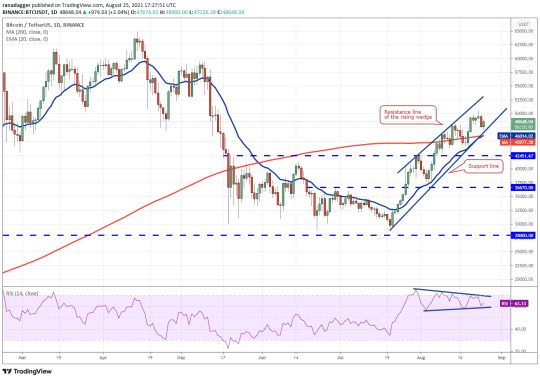
BTC / USDT daily chart. Source: TradingView
The bulls are currently defending the support line. If the rebound continues, the bulls will make another attempt in the overhead resistance zone of $ 50,000 to $ 50,500. If this hurdle is cleared, the BTC / USDT pair could rally to the resistance line of the wedge.
A breakout and close above the wedge indicates strength and could attract further buying. That could pave the way for a rally to $ 60,000. The rising 20-Day Exponential Moving Average (EMA) ($ 46,014) and Relative Strength Index (RSI) in positive territory indicate an advantage for buyers.
That positive view will be invalidated if bears let the price dip below the 200-day Simple Moving Average (SMA) ($ 45,977). This could result in a drop to $ 42,451.67.
ETH / USDT
The bulls pushed Ether (ETH) above the overhead resistance at $ 3,335 on Aug 23 and 24, but failed to hold the higher levels. This suggests that bears are aggressively defending the level.

ETH / USDT daily chart. Source: TradingView
The ETH / USDT pair fell to the 20-day EMA (USD 3,080) on August 25, but the candle’s long tail shows buying at lower levels. If the price holds above the 20-day EMA, buyers will make another attempt to push the pair above $ 3,335.
If they do, the pair could continue on its uptrend which could hit $ 3,670 and then $ 4,000. On the contrary, if the price drops again from $ 3,335, a few days of consolidation are possible. The first sign of weakness will be a breakout and a close below $ 3,000. If bears keep the price below this level, the pair could fall to the 200-day SMA ($ 2,352).
ADA / USDT
Cardano (ADA) saw profit bookings near the $ 3 psychological level on Aug. 24, but one positive sign is that the bulls are not giving up much ground. The long tail of the August 24th and 25th candlesticks suggests accumulation at lower levels.

ADA / USDT daily chart. Source: TradingView
If the price rebounds from the current level or the breakout level at $ 2.47, it will indicate that sentiment remains positive and the bulls will buy on dips. The bulls will then attempt to continue the uptrend by pushing the price above $ 3. If this succeeds, the ADA / USDT pair could rise to $ 3.50.
On the flip side, the pair may consolidate between $ 3 and $ 2.47 for a few days if the price again deviates from the overhead resistance. A break and close below $ 2.47 could push the price to the 20-day EMA ($ 2.20). The bears will need to drop the price below this support to gain the upper hand.
BNB / USDT
After the strong upward movement on August 23, Binance Coin (BNB) made an inside-day candlestick pattern on August 24. This indicates indecision between the bulls and bears. Right now, buyers are trying to resolve the uncertainty in their favor.

BNB / USDT daily chart. Source: TradingView
If the bulls push and hold the price above $ 509.72, the BNB / USDT pair could begin its journey north towards $ 600. The rising 20-day EMA ($ 420) and the RSI in the overbought territory suggest that buyers have the upper hand.
Contrary to this assumption, if the pair declines $ 509.72, the pair may drop to the breakout level at $ 433 and consolidate between these two levels for a few days. A break and close below the 20-day EMA could drop to $ 385.47 and then to the 200-day SMA ($ 358).
XRP / USDT
The long wick of the XRP candle on Aug. 23 shows that the bears are trying to stop the rebound in the $ 1.30-1.35 zone. This could have resulted in profit booking from short-term traders, causing a drop to the 20-day EMA ($ 1.08).

XRP / USDT daily chart. Source: TradingView
The bulls are likely to aggressively defend the breakout level at $ 1.07. If the price recovers from this support, the XRP / USDT pair could rise to the downtrend line and above to $ 1.35. A breakout and close above this resistance signals the resumption of the uptrend.
Contrary to this assumption, the pair could fall to the 200-day SMA ($ 0.86) if the bears push the price below $ 1.07. Such a move suggests that bullish momentum has weakened and the pair may trade in a range for a few days.
DOGE / USDT
Dogecoin (DOGE) broke off the downtrend line on August 24 and fell to the 20-day EMA ($ 0.28). Although the bulls have defended support, the lack of a strong rebound suggests a lack of aggressive buying.
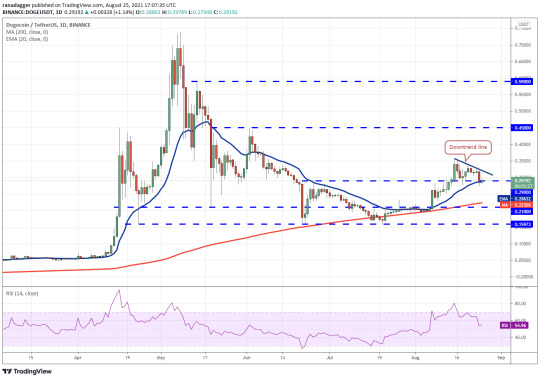
DOGE / USDT daily chart. Source: TradingView
If bears let the price dip below the 20-day EMA, the DOGE / USDT pair could fall to the nearest support at $ 0.21. Such a move suggests that the recent breakout above $ 0.29 was a bull trap. The pair could then stay in a range between $ 0.21 and $ 0.29 for a few days.
The flattening 20-day EMA and the RSI just above the middle also point to near-term consolidation. Conversely, if the price turns up from the current level and rises above the downtrend line, the pair can rise to $ 0.35. A breakout and close above this resistance could open the gates for an upside to $ 0.45.
DOT / USDT
The bulls’ failure to push Polkadot (DOT) above the overhead resistance at USD 28.60 in the past few days resulted in profit posting on August 24th. The price fell near the 20-day EMA ($ 23.84), but buyers are pegged to try.

DOT / USDT daily chart. Source: TradingView
The bulls will now make another attempt to push and hold the price above the overhead resistance. If successful, the DOT / USDT pair will complete a V-bottom that has a pattern target at $ 46.83.
On the contrary, if the rally fizzled out and the bears dragged the price below the 20-day EMA, it would indicate that the bullish momentum has weakened. The pair could then fall to $ 18 and stay in the range for a few more days.
SOL / USDT
Solana (SOL) is currently correcting the sharp upward movement of the last few days. This suggests that traders are making profits. The critical support to watch on the downside is the breakout level at $ 58.38.

SOL / USDT daily chart. Source: TradingView
The rising 20-day EMA (USD 59) and the RSI in the overbought area show that the bulls have the upper hand. If the price rebounds from $ 58.38, it will suggest traders continue to accumulate on dips. The bulls will then make one more attempt to resume the uptrend.
A breakout and a close above $ 82 could mark the next leg of the upside move. On the flip side, the SOL / USDT pair could stay in the range for a few days if the price drops from $ 82. A breakout and close below $ 58.38 suggests a strong comeback for the bears.
Related: Bitcoin erases the BTC price drop, but $ 48.2K is now the key to avoiding a bull trap
UNI / USDT
The long wick of the Uniswap (UNI) candle indicated that the bears continued to defend overhead resistance at $ 30 averages on Aug 23.
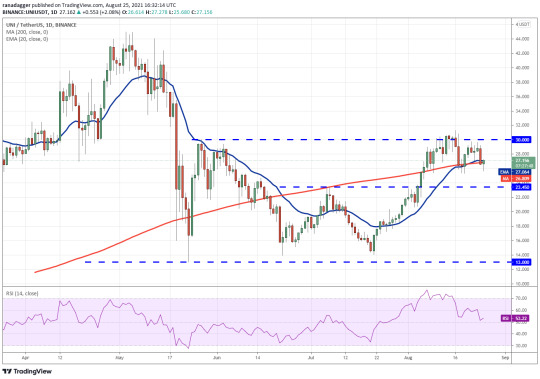
UNI / USDT daily chart. Source: TradingView
If the bulls cannot hold the price above the moving averages, the UNI / USDT pair could fall to $ 23.45. A strong rebound from this level suggests traders buy on dips. That could keep the pair in the $ 23.45- $ 30 range for a few more days.
The flat moving averages and the RSI near the middle point to some days of consolidation. A breakout and close above the overhead resistance zone of USD 30 to USD 31.25 signals the beginning of a new uptrend.
BCH / USDT
Bitcoin Cash (BCH) fell from the overhead resistance of $ 700 to $ 714.76 and fell below the 200-day SMA ($ 657) on Aug. 24. The bulls are currently trying to defend the 20-day EMA ($ 632) which is positive signature.
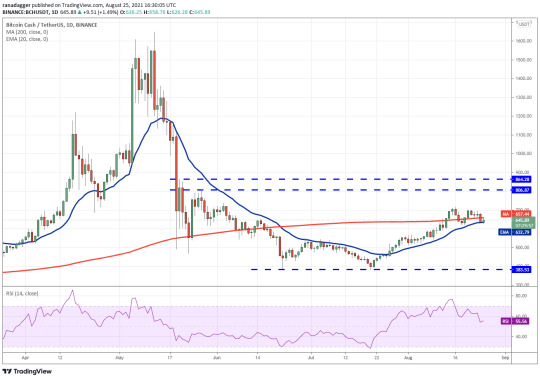
BCH / USDT daily chart. Source: TradingView
If the price recovers from current levels and rises above the 200-day SMA, the BCH / USDT pair could move into the overhead resistance zone. A breakout and close above this zone could open the doors to a rally to $ 806.87.
Conversely, if bears push the price below the 20-day EMA and the $ 619 support, the pair could see a lower correction to $ 588 and then to $ 550. Such a move will indicate a few days of consolidation.
The views and opinions expressed are those of the author only and do not necessarily reflect the views of Cointelegraph. Every investment and trading movement involves risks. You should do your own research when making a decision.
Market data is provided by HitBTC.
#bitcoin #Support

0 notes
Text
Trading altcoins at the edge of addiction – Cointelegraph Magazine
Whether I work in visual innovation or just work as a reporter, I made my job of immersing myself headlong into ideas I don’t know about.
The fresher and more complex the puzzle to be solved, the more I intervene and go from the unknown to the known. And if I’m lucky, I’ll get an all-day adrenaline rush and some unusual dreams in return for my services.
When I first started, I worked as a breaking news journalist – a job where I wrote up to six pieces of news a day. Furthermore, the pressure to understand every word at a presidential press conference, for example, can be insanely intense and require such unimaginable attention. The only comparison I could draw would be day trading cryptocurrencies.
And like crypto, my work would often visit me late into the night. Once in bed, I felt a cursor blink just behind my peripheral field of vision, or I saw foggy headlines being written and rewritten so that they would not exceed their character boundaries.
“US President seeks agreement with Iran on …” Delete, delete, delete. “President calls for trust with Iran …” Did I sleep? Did I whisper to myself? The questions were then as they are now.
Even if I picked up a box of cereal in the supermarket during this time, I could have the feeling that computer keys were being smooched between my fingers.
As I learned at the time, what I was experiencing was related to the so-called “Tetris Effect”.
When Tetris was released in the 1980s, people were so addicted to Russian-American engineer Alexey Pajitnov’s video game that they saw and heard it in everything they did.
In fact, a writer for Wired in the early 1990s called the game a “pharmatronics” in terms of its addictive powers.
Commenting on the game, journalist Jeffrey Goldsmith wrote, “For days I sat on a lavender suede sofa angrily playing Tetris. On rare trips out of the house, I visually bring cars and trees and people together. “
Sound familiar? Does anyone see crypto candlesticks?
Pajitnov told Wired, “You can’t imagine that. I couldn’t finish the prototype! I started playing and never had time to finish the code. People played, played, continued to play. My best friend said, ‘I can’t live with your Tetris anymore.’ “
Tetris dreams became a widespread topic of conversation among gamers and psychologists. In fact, psychiatry professor Robert Stickgold and his colleagues at Harvard Medical School found that of those they trained for the game, more than 60% reported dream of images associated with it.
Stickgold argued that these Tetris dreams were simply part of how people process information from our waking hours.
Tetris has also been associated with the “flow state”, the name for the groove you get when you focus so hard on a goal that the world around you melts away.
Kerr agrees that the crypto visions I’ve mostly had late at night sound like the Tetris Effect. But it quickly indicates that our brains are drawn to puzzles, no matter what.
“We are natural problem solvers. And crypto is like a big puzzle in some ways. Dreaming has been linked to problem-solving skills. And crypto is a problem that we want to solve and get it right and make money from it, ”says Kerr.
0 notes
Text
Big Ideas with Jason Potts – Cointelegraph Magazine
Economics Professor Jason Potts is co-director of the Blockchain Innovation Hub at RMIT University. He sees blockchain technology as a fundamental institutional technology revolution comparable to the emergence of companies and the internet — perhaps even as world-changing as the invention of electricity.
What’s the last big technological change that had the same sort of impact that you believe blockchain will have?
I think the obvious one is the internet, which was a profound revolution stringing together digital communication networks and computers to basically send the cost of communication and coordination to zero. But, it fundamentally didn’t change any of the economic infrastructures.
You still had to use money in the real world, you still had to use companies in the real world to intermediate and you still had to use contracts that were non digitally native. This is completing the revolution that was started with the internet by bringing the rest of the economy natively digitally online.
Before that, electrification of the economy was a process that took about 50 years. It was an 1860s and 1870s development, but it wasn’t really until, you know, the 1920s and ‘30s before we saw the full impact of it with electric motors and everything that just disappeared beneath the surface of the economy.
So, I think it is of that kind of class.
RMIT in Melbourne is home to the Blockchain Innovation Hub. Also, a very good journalism school that has produced notable alumni like the author (Source: Pexels)
Why is blockchain a fundamental infrastructure change rather than just another technology?
Most technologies that we have are industrial technologies for producing things: cars, steel, or whatever. Blockchain is an institutional technology. Instead of organizing matter, energy and things, it’s a technology for coordinating people.
We have these come along every so often. The joint-stock company invented back in the late Middle Ages was technology for organizing people. Once we had that, the world never looked back, as it fundamentally changed history and gave rise to modern capitalism.
The first ones were actually in the 16th century when the kings and queens of Spain and the Netherlands created these charter companies to go on these voyages around the world, to set up colonies and so on. The original use of companies was empire-building.
And then, we gradually realized that we could use them for all sorts of things. We can use them for building railways and we can use them for building steel companies, steel plants, and so on. Now, we use companies for almost everything.
So, a company is an institutional technology. Another example is clocks and synchronized time, and that gives us the ability to have timetables. And if we’ve got timetables, we can start scheduling, enabling us to have public transport systems that enable us to have factory days.
These new institutional technologies are relatively rare, but when they happen, they enable millions and millions of people to start to coordinate their actions and the economy.
Blockchain is exactly the same thing. It enables us to coordinate on shared information and truth, and we can all use this technology to figure out who owns a thing, what is the fundamental truth about ownership, who has agreed to buy something, or about identity, which is important for establishing reputation and rights to such things, or just anything else where we need shared agreement about information.
This fundamental institutional technology to enable us to trust information enables us to build a global digital economy on top of that.
This was the key understanding we arrived at. Blockchain technology isn’t just the next generation of the internet, it’s a fundamental way to create shared agreement about the sorts of facts that underpin a modern economy and to represent those in a purely digital form.
The electrical revolution took half a century. (Source: Pexels)
We could already do that, of course. The difference is you don’t have a centralized body telling you those things.
This is the breakthrough. We could always do that with a company if it got big enough, we can always do that with a sort of centralized government registry, especially if that registry was big enough, but none of those things scale to the level of the entire world. Any centralized solution to that problem gives whoever or whatever controls that registry an enormous amount of power.
This is the breakthrough that blockchain technology brings. It provides a distributed decentralized way of having that information be trusted, potentially open to anyone but able to be fully distributed.
Launching the DigitalCBD project today @BlockchainRMIT @rmit @RMITBusRes @matt_warren__ @chrisberg https://t.co/8qbvLl0Lka
— Jason Potts (@profjasonpotts) August 16, 2021
As for infrastructure, what possibilities does it open up?
We’ve had huge opportunities for automation, R&D and innovation and development in all the industrial parts of the economy over the last 200 years. But, it came with very little development in the underlying institutional registry.
The huge opportunity that we have is based upon a whole lot of administrative costs and infrastructural costs that have just simply been around so people can check everyone else’s work, verifying that someone has the right to sell the thing they’re trying to sell and verifying that someone is who they say.
All of that sort of administration, which has significant costs in a modern economy, has the opportunity to be automated, and then to be driven toward R&D and technological change into that domain that we see as a huge opportunity.
That’s what we mean by this is an institutional technology or an infrastructural revolution.
Professor Jason Potts (Source: RMIT)
You’ve done some research into this that estimates about $29 trillion worth of the economy is there simply to enable us to trust that certain things have happened, or that information is accurate.
At the Blockchain Innovation Hub, we tried to estimate the cost of trust in the modern economy. If everyone was perfectly trustworthy, all statements were true and all contracts were effortlessly enforced, what work wouldn’t we need to do?
We went through and just basically classified every single occupation in the U.S. for the amount of time, the percentage of each job and who is involved in creating trust. So, for example, an accountant basically only exists because one party doesn’t trust the numbers. A lot of managerial work is simply monitoring and verifying that someone did what they promised to do. The number we came to was about 35%, which was incredibly high. About a third of the economy is just simply devoted to checking each other’s work.
We argued that the significance of blockchain is a technology that has industrialized trust. That’s the productivity gain that is potentially there to be had, especially if we can industrialize and automate that process of being able to trust and verify the information that’s given to you.
At the moment, 1/3 of the entire global economy is spent doing something that we might not need to do anymore. It’s not going to go to zero. However, it was exactly the same with industrial technologies such as electric motors and petrol engines that replaced agricultural work that was being performed by animals and humans. Once upon a time, 90% of the economy worked in agriculture, and now it’s 3%.
That was a huge source of wealth in the 20th century. People moved off farms and into the cities, freeing up all those resources to do other things. That was the industrialization of work. We’ve got the same opportunity now with the industrialization of trust.
How long do you see this taking? Will the transformation take 50 years like electricity did?
It seems to be speeding up. All previous infrastructural technological changes — the big ones: electricity, communications networks and so on — were multi-generational transitions.
What has been amazing is how fast this transformation has already happened. There’s a number of reasons for that, but mainly, the internet has spread to most of the economy already and large amounts of the economy have already been digitized. Blockchain can only go where digitization has already gone. So, I think those conditions are very, very right for it to be rapid. We’re 10 years into what I think is probably going to be a 20-year process.
Another ramification of this revolution that you’re predicting is that we’ll see fewer big corporations in the future thanks to the emergence of blockchain as a coordinating force. Can you explain the theory there?
A firm is a large hierarchical structure. It has relatively high overhead costs in administration and running the organization. But, anyone inside the firm can, in principle, trust anyone else. We can make very low-cost agreements inside firms. But, when you’re undertaking large projects, firms have to be very, very large.
What we’ve seen over the past few 100 years is this gradual increase in the size of firms in order to do particular things, whether it’s banking systems, mining operations, or others.
That world of ever-increasing sized firms has all sorts of implications and consequences for society. We have to deal with the fact that they will accumulate not just enormous power but almost as enormous wealth. We have to have very strong countervailing economic, social and political forces to enable us to live in a world with global and very large hierarchical organizations.
Blockchain disrupts the efficiency of very large organizations. It enables people to make deals, contract with each other and form cooperative agreements to do things using peer-to-peer distributed blockchain technologies.
We’ve got a new way for large numbers of people to come together to cooperate, whether it’s really to offset risk, provide insurance for each other, or to sort of channel savings, investments and loans.
It means that we don’t need firms to be as big. If firms don’t need to be as big, then we can spend a lot less time worrying about controlling them. And all sorts of political implications follow from that.
Massive corporations may become a thing of the past. (Source: Pexels)
I recall very strongly from the early days of the internet that we all thought it was going to be a magical utopia of happiness and wonder — and it turned into a total mess. What are the negative things that blockchain and cryptocurrency could bring about?
The reason that utopia collapsed was because we still didn’t have digital money or companies to provide all of these things. We ended up importing large companies back into the space, which has caused most of the problems that we’re dealing with. How do we control Facebook? How do we deal with the power of those large platforms?
I think the main issue, this time, will be around privacy and the question of whether we can successfully get to pseudonymity.
There are other issues with censorship resistance and the ability of actors, platforms, companies, or governments — or just coalitions of other people — to censor and control individuals in this space.
The Chinese government seems to love blockchain and they don’t like things they can’t control. So, it seems like it could just turn into Big Brother everywhere.
Yeah. That’s a very illuminating example because where I think we’re headed, is that the global blockchain economy splits into two: There’s more or less a China version and then the everything else version. In the same way that the internet has already done that.
I think that the next version of where we’re headed is that same logic, just extended out to digital economies. Now, that scares me. I don’t like that. That’s not the promise of a free open global economy and a society built on open source platforms. That’s not the promise that a lot of crypto and blockchain pioneers in the cypherpunks had in mind two decades ago.
I worry that we will end up in a bipolar or multipolar world where there’s essentially — I hesitate to use the word empires — but it does feel like it’s getting back into that. The potential downside to this is that we end up with balkanized global digital empires again.
Joining DAOs is the new internships/ contributing to OS projects. A clear (costly) signal that you can contribute meaningfully to a productive community, and also an accelerated learning experience. Do it. https://t.co/QVxQZkyrM4
— Jason Potts (@profjasonpotts) August 17, 2021
Tell me about the RMIT Blockchain Hub in Melbourne
Back in 2017, when we started, we were the world’s first Social Science Research Center on the blockchain. There were lots of other computer science ones but we were the first ones that really grew out of a business school. Four of us started it. I, Chris Berg, Sinclair Davidson and Darcy Allen.
We came together as a group of economists, lawyers and business-school types to really look at this question: What impacts blockchain as an infrastructural technology, and does it have any effects on business models? How would it disrupt different sectors? How is it going to affect jobs, businesses, firms and so on?
That was always the idea: This is a massively important and disruptive technology. We want to try and understand this from the perspective of a business school.
Jason Potts is also the editor of the Journal of Institutional Economics and the author of numerous books about blockchain and contributes to the Mint and Burn podcast.
0 notes
Text
Walmart is seeking a crypto product lead, the Dogecoin Foundation is active again after a long break, Coinbase has amassed a $4 billion cash-backed war chest: Holder’s Digest, Aug. 15-21
Hodler’s Digest comes every Saturday and helps you keep track of every single important message that happened this week. The best (and worst) quotes, introductory and regulatory highlights, leading coins, predictions, and more – one week on Cointelegraph in one link.
This week’s top stories
Walmart seeks the lead in crypto products to advance the digital currency strategy
On August 16, it was reported that US retail giant Walmart was looking for a seasoned crypto professional who could develop and advance a digital currency strategy and product roadmap for the company.
According to the job posting, Walmart is looking for someone with a track record of running and scaling businesses. You would also like to have at least 10 years of experience in product / program management and technology-based product marketing.
Ideally, the candidate should also know a thing or two about crypto, blockchain technology, and why JPEGs from poorly drawn pet rocks on Ethereum are selling at absurd prices.
Walmart’s future head of digital currency and crypto products will be based in the company’s home office in Bentonville, Arkansas. The state has produced talents like Billy Bob Thornton and Johnny Cash, and Bill and Hillary Clinton.
Team officially re-establishes Dogecoin Foundation after 6 years
There was good news for Doge fanatics this week when the Dogecoin Foundation re-emerged after several years of total media silence.
According to an announcement on Tuesday, the foundation said it was re-establishing itself to raise the fiery Dogecoin (DOGE) Community. The foundation also announced it will announce new projects aimed at promoting the adoption of DOGE and promoting its benefits.
Ethereum co-founder Vitalik Buterin, Dogecoin co-founder Billy Markus and Dogecoin core developer Max Keller are listed as advisory board members on the project’s website. In addition, the interests of Tesla boss and DOGE advocate Elon Musk can be covered from the shadows by Neuralink CEO Jared Birchall.
It is not yet known whether Musk’s “toddler Hodler” son loaded onto DOGE in light of the announcement.
Coinbase is amassing a $ 4 billion war chest so that it can survive the “crypto winter”
Coinbase, the leading U.S. crypto exchange, has amassed a $ 4 billion cash-based war chest in two very productive quarters for the company.
The company reportedly expected to use the cash to cover costs caused by a variety of factors, including compliance with new U.S. lawmakers’ regulations.
Coinbase has its too official launch in Japan in partnership with banking giant Mitsubishi UFJ Financial Group while revealing plans for expansion $ 500 million worth of crypto move into the balance sheet and invest 10% of all profits in future in digital assets.
Winner and Loser
At the end of the week, Bitcoin is at $ 48,778, Ether at $ 3,282 and XRP at $ 1.28. The total market capitalization is $ 2.09 trillion, according to to CoinMarketCap.
Among the 100 largest cryptocurrencies, Avalanche are the three best altcoin winners of the week (AVAX) at 105.79%, arweave (WITH) at 96.17% and Audius (AUDIO) at 93.78%.
The three biggest altcoin losers of the week are DigiByte (DGB) at -5.06%, Celsius (CEL) at -4.44% and BitTorrent (BTT) at -3.81%.
For more information on crypto pricing, be sure to read Market analysis by Cointelegraph.
The most memorable quotes
“Poly Network has no intention of holding Mr. White Hat legally responsible, as we are confident that Mr. White Hat will immediately return full control of its assets to Poly Network and its users. As we have said in previous announcements and encrypted messages that have been released, we are grateful to Mr. White Hat’s outstanding contribution to the security improvements made to Poly Network. “
Poly Network team
“Legislators and regulators must work together to bring innovation protection in line with all new regulations to ensure the digital asset market thrives in the United States.”
Glenn Thompson and Patrick McHenry, US representatives
“The most important thing that can be done today is to move away from the idea that coin voting is the only legitimate form of decentralizing governance.”
Vitalik Buterin, co-founder of Ethereum
“Here at home in America, […] Our payments infrastructure is arguably the worst of any developed country in the world and is falling increasingly behind, while China works with determination and rush to build an infrastructure that will make the digital yuan a challenger to the dollar as a world reserve currency. “
David Marcus, co-creator of Diem
“Ethereum outperforms Bitcoin and it is expected that this trend will continue for the remainder of 2021.”
Nigel Green, CEO of the DeVere Group
“Everything here revolves around DeFi. […] This is the Treasury Department trying to figure out how to get jurisdiction over DeFi. receives […] and also to expand the liability-free monitoring of a peer-to-peer financial system. “
Jake Chervinsky, General Counsel at Compound
“To be honest, as one of the first pilots, we have the question of paying salaries to employees of the Ministry of Digital Transformation in electronic hryvnia on the table.”
Mykhailo Fedorov, vice prime Minister of Ukraine
“It’s important to remember that when looking at the business, the long-term arc of digital asset adoption in cryptocurrencies is far more important than the businesses we are building.”
Mike Novogratz, founder and CEO of Galaxy Digital
Forecast of the week
The “liquidity crisis” of Ethereum could reach a new ETH all-time high before Bitcoin – analyst
Bitcoin, the crypto industry’s largest asset by market capitalization, and Ethereum (ETH), the second largest asset, have both seen notable rallies in recent weeks. Although BTC as the top dog in the crypto industry has yet to be surpassed, according to the thoughts of CryptoQuant CEO Ki Young Ju, ETH could reach its own all-time high of 4,400 USD before BTC hits its record high of almost 65,000 USD.
“In the long term, $ ETH could reach its all-time high earlier than $ BTC,” Ju tweeted on Wednesday. “The current $ ETH price is closer to ATH compared to $ BTC. Higher demand, lower supply. The $ ETH sell-side liquidity crisis is still worsening while the $ BTC foreign exchange reserve halted its downtrend in May. ”
On Friday, BTC surged above the $ 48,000 mark, and ETH traded above $ 3,200 – both of which are still well below their record highs.
FUD of the week
JPMorgan Chase is reportedly closing bank accounts for the bitcoin mining company
On August 19, US banking giant JPMorgan Chase reportedly suspended all account activities of Bitcoin mining company Compass Mining.
Whit Gibbs, the CEO of Compass Mining, went to Twitter to share the news:
“Greetings to @Chase for closing @compass_mining accounts because we’ve done our part in replacing the old guard with self-confident, forward-thinking hard money backers. Stand behind #Bitcoin or avoid us. “
It’s unclear whether the tantrum will be enough to get JPMorgan Chase to change his mind, and it’s also unclear how the shutdown of banking services to a Bitcoin mining company constitutes an attack on BTC in any way.
If anything, the banking giant increased its exposure to Bitcoin and the crypto sector in 2021.
$ 80 million liquid exchange hacked
Liquid, a Japanese crypto exchange, was the victim of an over $ 80 million hack this week that made the platform less … liquid.
Cointelegraph quickly covered the news after the exchange announced the attack that struck digital assets like BTC, Tron (TRX), Ripple (XRP) and ether.
The exchange stated that only their hot wallets would be affected, adding that their assets would be moved to a cold store for security reasons.
The platform has since provided an update, revealing that the hack totaled $ 91.35 million. The company has asked users not to place any crypto assets in liquid wallets until further notice.
T-Mobile investigates potential data hacks from 100 million customers
Speaking of hacks, the US telecommunications giant T-Mobile investigated a suspected massive data breach earlier this week that may have compromised the information of more than 100 million users.
According to Vice’s motherboard, T-Mobile is investigating a potential data breach alleged by an author who posted details on an underground forum. A report on Sunday said the hacker obtained data from more than 100 million customers from T-Mobile servers.
Unlike the Poly Network hacker who $ 600 million skimmed off worth of digital assets because “cross-chain hacking is hot,” the T-Mobile hacker seems to have entrepreneurial instincts when he asked for 6 BTC – worth around $ 280,000 at current prices – in exchange for some of the dates.
Best Cointelegraph Features
Shanghai Special: Crypto Raid Fallout and What Happens Next
Bitcoin possession is not prohibited, but many fear for the future of regulations in China. Here you can see where we are and where we could go.
Poly Network Hack Reveals DeFi Bugs, But Community Comes To The Rescue
The DeFi hacker’s original intentions remain unclear, but they refused to accept a $ 500,000 bounty after returning all funds.
The Perfect Storm: DeFi Hacks Will Advance The Crypto Sector
There’s a silver lining to the DeFi hacks’ horizon as new technologies develop to protect the sector: “DeFi will be a lot safer in 12 months.”
0 notes
Text
Price analysis 8/20: BTC, ETH, ADA, BNB, XRP, DOGE, DOT, SOL, UNI, BCH
Wells Fargo, in partnership with NYDIG and alternative asset manager FS Investments, has registered a new mutual fund called “FS NYDIG BITCOIN FUND I”, which enables the bank’s wealthy customers to invest indirectly in Bitcoin (BTC).
Another sign of growing institutional interest is BlackRock’s filing with the U.S. Securities and Exchange Commission, showing a 6.71% stake in Marathon Digital Holdings and a 6.61% stake in Riot Blockchain. BlackRock’s total investments in the two publicly traded Bitcoin mining companies are estimated at approximately $ 384 million.

Daily performance of the cryptocurrency market. Source: Coin360
Brian Armstrong, CEO of Coinbase, announced on Aug. 20 that the company’s board of directors has approved a proposal to add $ 500 million worth of crypto to the balance sheet and use 10% of the profits generated for future crypto purchases.
With this move, Coinbase will be the first publicly traded company to include Ether (ETH), decentralized financial tokens and proof-of-stake assets on its balance sheet.
Institutional interest in crypto continues to grow and that could bode well for the sector in the future. Let’s study the charts of the top 10 cryptocurrencies and determine the critical values to watch out for.
BTC / USDT
Bitcoin has witnessed an uphill battle between the bulls and bears for the past few days near its 200-day simple moving average ($ 45,692). The bears dragged the price below the 200-day SMA on August 17th but failed to break the support of the 20-day exponential moving average ($ 44,183).
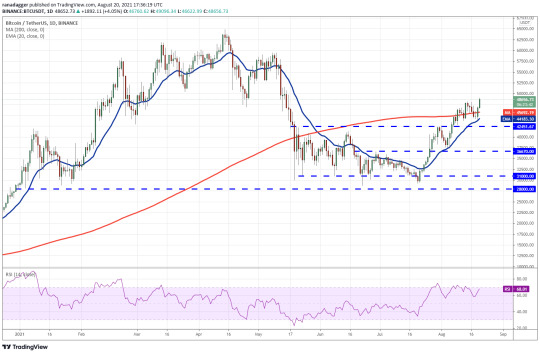
BTC / USDT daily chart. Source: TradingView
Aggressive buying on the 20-day EMA pushed the price back above the 200-day SMA on August 19th. The rising 20-day EMA and Relative Strength Index (RSI) near the overbought area show that the bulls are in control.
If buyers hold the price above $ 48,144, the BTC / USDT pair could gain momentum, rising to $ 51,500 where the bears could again build strong resistance. If the bulls can hold back the subsequent decline above the 200-day SMA, it will signal strength and increase the prospect of a continuation of the uptrend.
A breakout of $ 51,500 could set the course for a possible surge to $ 60,000. This bullish view will be voided if the price goes down and falls below the breakout level of $ 45,451.67.
ETH / USDT
Ether turned down from $ 3,335 on August 16 and the bears attempted to pull the price below the breakout level of $ 3,000 on August 17 and 18. Although the price fell below this support, the bears were unable to sustain lower levels, suggesting strong buying from the bulls.

ETH / USDT daily chart. Source: TradingView
The ETH / USDT pair rallied from the 20-day EMA (USD 2,981) on August 19th, suggesting that the bulls are aggressively defending this support. Buyers will now seek to push the price above the overhead resistance at $ 3,335. If they do that, the pair could begin their $ 4,000 journey.
Contrary to this assumption, if the pair fell from $ 3,335, the pair could fall back to $ 3,000 and consolidate in that narrow range for a few more days. A breakout and a close below $ 3,000 is the first sign that the bulls are losing their grip. The pair could then fall to the 50-day SMA ($ 2,311).
ADA / USDT
The bulls flipped the $ 1.94 level in support on August 17th and 18th. This attracted further buying and the bulls pushed Cardano (ADA) above the all-time high of $ 2.47 today.

ADA / USDT daily chart. Source: TradingView
The ADA / USDT pair could now climb to $ 2.73 where it is likely to encounter strong resistance from the bears again. If the bulls break this resistance, the pair could hit the psychological barrier at $ 3.
Although the trend is favoring the bulls, the RSI near 80 shows that the rally is overdrawn in the short term. If the price slips below $ 2.47 and holds, the bears will try to push the pair down to $ 2.20. A break below this level suggests a short-term slowdown in momentum. The pair could then hit the 20-day EMA ($ 1.87).
BNB / USDT
Binance Coin (BNB) fell from the overhead resistance at $ 433 on Aug 17, but the bulls did not let the price fall below the 20-day EMA ($ 384).

BNB / USDT daily chart. Source: TradingView
A strong rebound from the 20-day EMA has pushed the price above the tough resistance at $ 433. If the bulls keep the price above $ 433, the BNB / USDT pair could begin its march north toward $ 520 and then toward $ 600.
The rising moving averages and the RSI in the overbought territory indicate that the path of least resistance is on the upside. That bullish view will be dashed if the price goes down and falls below the 20-day EMA. This could lead to a drop to $ 340.
XRP / USDT
XRP broke the downtrend line of the descending channel and the overhead resistance at $ 1.07 on Aug 13, completing a rounded bottom pattern. The bears tried to push the price back below $ 1.07, but the bulls thwarted their attempt.

XRP / USDT daily chart. Source: TradingView
The strong rebound from $ 1.07 on August 18th shows that the bulls have successfully flipped that level into support. The XRP / USDT pair could now climb to $ 1.70. This level could act as strong resistance, but if the bulls break this hurdle the pair could rise to $ 1.96.
Alternatively, if the price goes down from $ 1.35, the bears will attempt to pull the pair below $ 1.07 and the 20-day EMA ($ 1.01). If successful, the pair could fall to the 200-day SMA ($ 0.84). Such a move will indicate that traders have outsourced their positions to higher levels.
DOGE / USDT
Dogecoin (DOGE) broke and closed above the $ 0.29 resistance on August 14, clearing the way for a rally to $ 0.35. The bears hit strong resistance at this level on August 16, pulling the price back to the breakout level at $ 0.29.
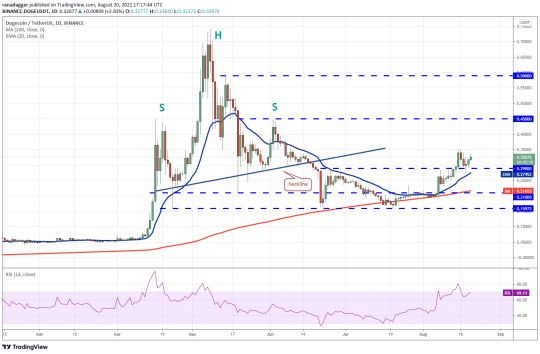
DOGE / USDT daily chart. Source: TradingView
The bulls successfully defended the breakout level at $ 0.29 on August 21st, indicating positive sentiment. If buyers lift the price above $ 0.35, the DOGE / USDT pair could rise to the nearest overhead resistance at $ 0.45.
Conversely, the bears will try again to lower the pair below the 20-day EMA ($ 0.27) if the price drops from current levels or $ 0.35. If they do, the pair could fall to the nearest support at $ 0.21.
DOT / USDT
Polkadot (DOT) turned off the 200-day SMA ($ 27.52) on August 17th, but the correction was short-lived as the bulls bought the dip on August 18th. Buyers drove the price above the 200-day SMA today.
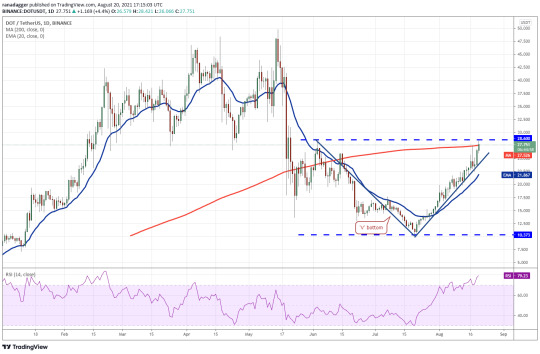
DOT / USDT daily chart. Source: TradingView
The DOT / USDT pair will complete a V-shaped bottom as it rises and closes above the USD 28.60 resistance. This setup has a target target of $ 46.83.
Such a move may not be easy, however, as the RSI has risen deep into the overbought territory, suggesting that the rally is overdrawn in the short term. That could lead to a slight correction or consolidation in the next few days.
If the price recovers from the 20-day EMA ($ 21.86) the bulls will try again to push the price above $ 28.60. Alternatively, a break below the 20-day EMA suggests the pair may expand its range-bound action in the near future.
SOL / USDT
Solana (SOL) rose above the $ 44 resistance on August 13. The bears attempted to pull the price back below the breakout levels on August 14, but were unable to hold the lower levels. This shows that the bulls were in no hurry to give up their positions.

SOL / USDT daily chart. Source: TradingView
The SOL / USDT pair broke the all-time high of $ 58.38 on August 16 and has continued on its way up. The strong rally of the past few days has pushed the RSI above 89, suggesting that the upward move is overdrawn in the short term.
This could result in a consolidation for a few days or a minor correction where the price could retest the breakout level at USD 58.38. If the bulls reverse this level into support, the rally could resume and hit the psychological level at $ 100.
The bears will need to pull and hold below $ 58.38 to weaken bullish momentum.
Related: Bitcoin is attacking the last resistance before $ 50,000 with BTC price closing daily, crucial now
UNI / USDT
The bulls’ failure to hold Uniswap (UNI) above the overhead resistance at $ 30 resulted in profit posting which dragged the price down on August 16. Although bears pulled the price below the moving averages on August 18th and August 19th, the lower levels failed.

UNI / USDT daily chart. Source: TradingView
The strong rebound from the 20-day EMA ($ 26.60) on August 19 suggests sentiment remains positive and the bulls will buy on dips. The bulls will now try again to push the price above the overhead resistance at $ 30.
If successful, the UNI / USDT pair could start a new bullish trend. The initial upside target is $ 37 and if that level is exceeded the pair could retest the all-time high of $ 45.
Conversely, the pair can fall to the 20-day EMA if the price falls from $ 30. A break through and a close below this level could lower the price to $ 23.45.
BCH / USDT
Bitcoin Cash (BCH) broke the 200-day SMA (651) on Aug 13, but the bulls were unable to extend that advantage. Sensing an opportunity, the bears pushed price back below the 200-day SMA on August 17, but failed to break the support at the 20-day EMA ($ 613).
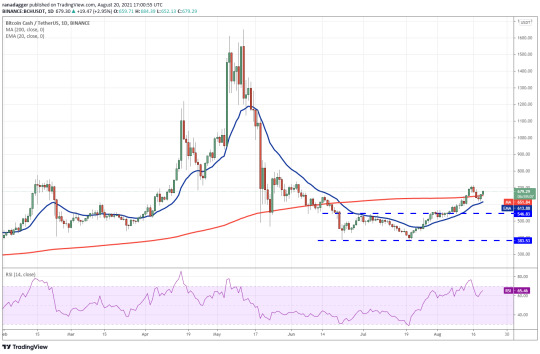
BCH / USDT daily chart. Source: TradingView
This suggests that sentiment has turned positive and traders buy on dips. The bulls pushed the price back above the 200-day SMA on August 19 and will now attempt to push the BCH / USDT pair above $ 714.66.
If they do, the pair could climb to $ 800 and then $ 864.28. On the flip side, the pair could slide to $ 546.83 if the price breaks down from current levels or overhead resistance and falls below the 20-day EMA.
The views and opinions expressed are those of the author only and do not necessarily reflect the views of Cointelegraph. Every investment and trading movement involves risks. You should do your own research when making a decision.
Market data is provided by HitBTC Exchange.
#altcoin prices #bitcoin
0 notes
Text
Li Jin of Atelier – Cointelegraph Magazine
It was once said that the internet would allow anyone with 1,000 fans to make a living, but Li Jin believes that in the age of the NFTs, one or two serious supporters might be enough.
Jin is a standard-bearer of the “passion economy,” which she describes as an economic system that enables and encourages people to make money while pursuing their passions. For Jin, NFTs are a new tool that helps creators in the passion economy reach their “true fans” and build lasting relationships with them.
Through her venture company Atelier, Jin invests in “platforms that lower the barriers to entrepreneurship and expand the way to work”. With her past in venture capital, she is well positioned to change the way we think about work.
Bring back the passion
“It was my dream to live in Paris, so I’m just hanging out here for now,” Jin tells the magazine towards the end of the interview, which takes place after the highly anticipated Ethereum Community Conference, also known as EthCC, that closes took place in the city. Despite admitting that she “doesn’t quite understand why people are working on DeFi,” which drew conference attendees’ attention, Jin organized “a lunch for people working at the intersection of crypto and creator economies.”
The current travel difficulties are a good reason to enjoy every bit of a new city, but hanging out in a new place is not something the average worker can do “for the time being” as they tend to be chained to cumbersome things like physical offices and chained scheduled, mandatory face-to-face meetings. However, this is not the case with many YouTubers – especially with those in the Passion Economy.
After all, why do we work? When you ask a child what they’d like to do when they grow up, the answer is often – hopefully – full of playfulness and passion. When asked why they chose a particular profession, the answer rarely revolves around salary, job security, or benefits. As they grow up, many seem to give up on these core motivations and instead seek a livelihood by fitting into a corporate structure or mindlessly doing freelance assignments.
According to Jin, the passion seems to be coming back. There is a “shift from gig marketplaces built around truly standardized services and products to more flexible, creative marketplaces that would actually allow people to generate income from the things they really love,” explains they are optimistic.
This is at the core of the Passion Economy, which is “a new type of work that is completely separate from a traditional employer-employee relationship”. This means that a passionate “worker”, if you can call him that, is neither responsible for bosses in a corporate structure nor as an interchangeable – or fungible – freelancer à la Fiverr or Uber. Instead, they just do their thing – and customers / subscribers pay for the privilege of being part of the journey.
Jin’s first NFT sold for $ 25,000.
In a sense, the result of any creative worker – be it written, designed, or painted – is in fact an unreproducible, unjustifiable “mark” of his or her endeavors. This article is indeed an off-blockchain NFT created by me – sold to the magazine but forever attached to me. The work performance of non-creative workers such as security guards or Uber drivers is decidedly less like a unique NFT, but more like a standardized, unrestricted “work hours” token with a clear market value.
The relationship between NFTs and creative work is far more than just an associative play on words as technology enables creatives to shape their work on the blockchain and capitalize on their sales and resales.
“This year, many creators became aware of crypto and what it could do for them to generate income in ways that were not possible before.”
Venture capitalist
Jin is from Beijing and her academically minded parents immigrated to Pittsburgh in the early 1990s. She describes how she grew up “very poor” in her early years in America, which led her parents to push her into a safe career.
She enrolled at Harvard University in 2008, but her parents were dissatisfied with her major in English literature and told her that she was doomed to become a starving writer and that her decision would “bring shame to the family.” To appease her parents, Jin switched to statistics.
For her first job, she worked as a reporter for the Pittsburgh Post-Gazette, where she “was sent to report on the G20 conference when she was 19”. In 2011 she worked in Mergers & Acquisitions at Blackstone during her studies and later worked for several years as a strategy associate at Capital One and product manager at Shopkick. a mobile shopping startup in Silicon Valley.
When Shopkick was acquired, Jin “wasn’t sure I was going to have my next role in technology” and followed the path of her peers, starting a Masters in Business Administration from Wharton in 2016, but continued to apply for jobs “If you want to stay “In technology, you might want to try venture capital – it’s a really great way to get a bird’s-eye view of the entire industry,” advised one mentor.
It broke off two weeks after receiving an offer from Andressen Horowitz, the famous venture capital company also known as a16z. “I didn’t really want to go to business school,” she recalls.
As a deal partner, Jin was responsible for “meeting with startups all day, talking to founders, taking pitches, helping with the due diligence process,” and often sat on company boards as an observer for her employer. Many of these companies have been what Jin calls “consumer creator platforms,” like Imgur, Patreon, and Substack.
For Jin, these companies signal a “shift from the gig economy to the passion economy, where new platforms allow people to make a living what they love and monetize their individuality”. Little by little, the tools that enable a thriving creative middle class are being released. In her article “100 True Fans” from February 2020 ” lays a formula that enables creatives to make a mid-range income of $ 100,000 per year with just 100 real fans, each contributing an average of $ 83 per month.
Today, much of the “middle class” of creatives that Jin featured remains digital farmers “who probably upload millions – hundreds of millions – of pictures to Instagram every day and receive no share of advertising revenue.”
“Instagram does a lot of advertising, but YouTubers don’t see any of it – I see that as 100 percent taxation.”
Artists receive no material benefit even when millions look at their profiles. Instagram, on the other hand, has earned “billions in equity” through the work of its posters – why shouldn’t content creators demand a share of the cheese? Beeple posted nearly 5,000 works of art before finally cashing in tens of millions with the NFT boom.
1,000 vs. 100 real fans in comparison. Source: a16z
In July 2020, Jin decided it was time to practice what she was preaching and “build an entire company dedicated to this particular emerging category, and I did – and I felt like the best too The way to understand something and to evaluate it means to live it yourself. “
The result was Atelier, an investment firm with an initial portfolio of $ 13 million of platforms that enable Users to forge their own future.
“I founded Atelier to fund a certain vision of the world: a world where people can do what they love to earn a living and lead a fuller and more meaningful life.”
Crypto connection
Jin first encountered cryptocurrencies in 2017 when her employer, a16z, “became one of the earliest funds to set up its own crypto fund”. Although she often worked with people involved in the fund, she found the industry abstract as it “didn’t touch the everyday consumer yet”.
This year things have changed.
“There were a lot more interfaces with consumers and the creator economy, especially this year with NFTs.”
NFTs, Jin believes, take their idea of 100 real fans even further. “You could only have one real fan, or ideally like two real fans bidding against each other,” she explains. Although ultimately only one person would own any digital asset, “their content can still be freely available and go viral”, creating a chain reaction that makes it even more likely that true fans “who really appreciate the original and are willing to to pay for it ”. Version “is coming.
Atelier investment. Source: Atelier
To To write In an essay titled “The Case For Universal Creative Income,” Jin auctioned an NFT representing the item in April of this year for 5,6969 ETH – all of which were donated to the Yield Guild Games Sponsor A-Scholar Program. Although anyone can read the article for free, someone paid 5,6969 ETH for the original.
Jin believes that creatives should see crypto as a way to monetize their work in what she calls the third step of the creative industries funnel. The first step is “How do I build my audience – how do I get discovered?” The second step is “How do I involve my audience more deeply?”
A lesson from Jin’s course.
Although cryptocurrency and NFTs have tremendous potential as rocket fuel for the passion economy – a term Jin coined – their primary focus is on empowering creators to make the leap. She leads the “Building for the Creator Economy” course, which teaches the participants the specifics of their world for three weeks.
Earlier this year she also launched the Atelier Angels Pilot Program to help train 30 founders become angel investors – gaining additional sources of income and learning more about the business at the same time. For Jin and Atelier, the future belongs to the makers – so who better to invest in it?
0 notes
Text
Crypto crackdown fallout and what happens next – Cointelegraph Magazine
The summer of regulatory action has meanwhile become a global phenomenon. Legislators and politicians wave their fingers and threaten the leading providers of virtual asset services in the industry – a term embossed from the FATF to describe exchanges, wallets, custodians, and even DeFi platforms.
But when it comes to raids against cryptocurrencies, few places with the effectiveness and experience of the Chinese government do so.
Unlike in the United States, China’s regulators do not have a public debate about it. Decisions are made behind closed doors and announcements come quickly, posted on government websites or in speeches by well-prepared officials.
The guidelines come from the top and are quickly repeated and enforced by subordinate provincial or city government officials, state-owned corporations, and financial institutions. This top-down style of regulation makes the “China ban” appear very repetitive and strict. In reality, the same regulation can be repeated dozens of times by different industries, which terrifies the public but has very little additional impact on the industry.
3000 kilos #bitcoin Miners packing to be flown to the United States. pic.twitter.com/d07y5GUBB3
– 8BTCnews (@btcinchina) June 21, 2021
What’s the problem this time?
While ownership of cryptocurrencies was never officially banned, there was likely a need for reform in other areas of the industry. The Chinese government has pushed regulations with the aim of protecting consumers, moving closer to carbon neutrality goals and achieving greater financial stability, according to Winston Ma, former general manager and head of North America for China Investment Corporation.
While the latter reason is more subjective, it cannot be denied that China’s opportunistic mining industry and speculative private investors were largely unbridled at the start of the year.
Ma will be among the first to see the effectiveness of the changes being made, especially for the mining industry, telling the magazine:
“So far, the effects are most obvious from an energy perspective: After the central government launched the campaign to crack down on cryptocurrencies in May, large coal-based electricity producers like Inner Mongolia and Xinjiang, which previously belonged to the two largest cryptocurrency mining hubs in China, have been part of it the first regions to quickly develop local rules for cleaning up mining companies. ”
This will not be a short term adjustment. Most of the major mining companies have moved overseas, and the overall hash rate of BTC mining is still there Low around 40% from the spring highs before the crackdown. Energy and climate policy were at the heart of China’s important five-year plan, the Approved this spring, underscoring the importance of cleaner energy consumption for the foreseeable future.
Despite its importance to the crypto community, mining doesn’t add much to national GDP. Revenue for Chinese miners was just under $ 7 billion far too insignificant a number for the 12 month period ending June to move the needle for government.
The revenue from the ride-sharing app Didi was alone over three times that in 2020, and the Chinese government hesitated very little take tough action after it was found to have provided user data to US regulators. Didi apps have been removed from domestic app stores, and now competitors are lining up to capture massive market share should Didi fail to resolve its legal issues.
Although Chinese miners made money, it was nowhere near enough to fend off government regulation (data from June 2021).
Sally Wang, Vice President of Portfolio Marketing at Sino Global Capital, notes that the number of blockchain use cases has increased tremendously at the national, regional and city levels, despite the fact that Chinese regulators do not tolerate areas of risk that threaten financial stability.
“We’ve seen miners leave China, and we’ve also seen big fintechs like Alibaba experiment with NFTs. Tokenless blockchain projects in China have seen tremendous growth. ”
This type of development has allowed players to continue contributing to a healthy blockchain ecosystem in China, with local governments hosting major events like the World Blockchain Conference in Hangzhou and the coming International Blockchain Week in Shanghai in September.
Regulatory influence on the decline
The original raid The banning of ICOs and exchanges in 2017 hit the crypto industry at a fragile time. Most of the world’s trade at the time came from China or took place on Chinese stock exchanges, and the major ones were registered and based in the mainland. This made them at the mercy of the authorities and taught the industry a valuable lesson in dealing with geographic risk.
After that, key industry players like Binance, Huobi, and OKEx began moving to places like Hong Kong and Singapore, where regulators were more open-minded. As a result, these exchanges are now easily removed from the jurisdiction of the Chinese government, provided they are not too conspicuous when recruiting Chinese users.
Flashback to 2017: This Cointelegraph graphic shows how fearful the industry was after the future of many major exchanges was questioned.
As more of the industry moves overseas, the influence of regulators will diminish. Unfortunately, the miners who wanted to harness the low-cost energy from China’s abundant hydropower and coal-fired power plants haven’t been decentralizing anytime soon. This put them in a precarious position and triggered a wave of panic in China Cracked down on miners earlier this year. The good news for investors is that miners have now also relocated overseas, reducing the need for future negative regulation against the mining industry.
Reading the tea leaves with regulators
The retail trade is still a great deal of uncertainty as large, predominantly Chinese, exchanges such as Huobi and OKEx form around 20% of the global volume, according to FTX’s voicelume monitor. Binance accounts for over 50% of the global volume and likely has a large percentage of Chinese users as well.
While users cannot buy cryptocurrencies directly with fiat on these platforms, P2P transactions still make it easy for savvy users to buy on platforms like Binance by using Chinese bank accounts and commercial payment apps to switch between the yuan and stablecoins Act.
So far, the government has failed to throttle this volume, although bank accounts are occasionally frozen for transactions in P2P markets. The sheer volume of digital transactions makes this difficult to monitor, but it is possible that the government is not as keen on eliminating these channels entirely. Full shutdowns of exchanges and retail investors might be possible, but it would risk freezing China without a horse in the race – something China is reluctant to do.
Wang believes large-volume exchanges from China will continue to adapt, tells the magazine: “We anticipate that they will follow the global trend towards tighter compliance, and as we’ve seen they have already tried to limit leverage and reduce the scope of products available to new users.” Wang points out that, what happened earlier this year when exchanges like Huobi restricted users Access to futures, a popular but high risk product that is often more like gambling than investing.
Ma remains less convinced of the short term future:
“China’s securities and banking regulators have yet to enact new regulations for trading cryptocurrencies. The uncertainty could mean real, long-term downward pressure on cryptocurrency prices. “
Ma isn’t the only one worried about what’s next. Many people in the Chinese community, including early entrepreneur Bobby Lee, have raised similar concerns, especially after seeing regulators aim among so many companies and individuals in China’s private technology sector this summer.
Should further action be taken against retailers, many Chinese users could be concerned about their ability to cash out in the future, creating more fear in the markets. Then the question arises whether scandals, fraud and social unrest due to speculative investments could force the government to act. The best bet for cryptocurrency holders is an increase in sustainable development that is more technology focused. Rising prices for meme tokens like Dogecoin and Shiba Inu may be attractive to short-term traders, but it increases the likelihood that the government will put pressure on retail users and the exchanges serving them.
A Chinese saying Taking wisdom is the idea of kill the chicken to scare the monkey.
In this story, a man slaughters a chicken to teach a lesson to his cherished dancing monkey. In comparison, China’s regulators won’t be shy of crushing a company if it means others will follow suit.
The international crypto community should hope that China’s leading projects will be able to navigate these new guidelines unscathed and continue to build a healthy blockchain ecosystem. Chinese entrepreneurship has consistently spawned the largest stock exchanges and major mining companies like Bitmain and Canaan, not to mention many of the leading venture capitalists and investors who have shaped the industry. The regulators’ next step could be an important one as we can figure out whether the top players will be the chicken or the monkey.
0 notes
Text
Hack of little-known Poly Network highlights East-West crypto divide – Cointelegraph Magazine
This weekly roundup of news from mainland China, Taiwan, and Hong Kong attempts to curate the industry’s top news, including influential projects, changes in the regulatory landscape, and corporate blockchain integrations.
To ThorCHAIN and Chain swap It is safe to say that hacking cross-chain bridges seems to be the style of the season. This week it was the local Poly Network project that got fleeced $ 615 million before leading the crypto community on a dramatic witch hunt to track down the attacker. While most news outlets have covered this story at length, there are still a few points worth analyzing.
Who are these projects?
The first point is that most Western DeFi users had never heard of Poly Network, despite amassing a total of over $ 600 million in total. Primitive Capital’s Dovey Wan reported on Twitter when she stated that “the Chinese crypto community always has its own version of using the same blockchain infrastructure for better or for worse, most of which are invisible and inaccessible to Westerners. “
It was only after Poly was hacked that most CTs found out about this “Crosschain” project with over $ 500 million TVL, just like the PlusToken case in 2018
In mainland China there is a VERY lively but completely different “Defi” community, despite the ban, despite a lot of carpets and hacks
– Dovey “Rug The Fiat” Wan (@DoveyWan) August 11, 2021
Why are Chinese projects so far under the radar? The first reason could be a cultural and language barrier as Chinese marketing teams struggle to integrate into the fast-paced and esoteric world of Crypto Twitter.
Instead of trying to win over global communities, they focus on integrations that users can address directly.
According to SimilarWeb, Poly Network gained over 58% of its web traffic from referrals to third party websites, with Chinese DApps OpenOcean, O3 Swap and Wing Finance topping the list. In contrast, Compound Finance receives more than half of its visits from direct hits, with only 16% coming from third-party websites.
Compound’s two top referral websites are CoinMarketCap and CoinGecko. This shows that the difference in behavior between Chinese and international users is fairly palpable and that two very different strategies are required to capture both target groups.
A DeFi Island: Chinese dApps and websites are the primary entry points for Poly Network users. Source: Similarweb
Untangling the web
Another taboo subject is that many of these large Chinese DeFi projects have ties to other projects. Poly Network has links to the O3 network, which Neo itself incubates. The extent to which Neo is involved is unclear, but it explains why Poly Network founders rarely market in public. These “founders” are often just the figureheads of the parent company. The parent company benefits from all the advantages of introducing a second token without running the reputational or legal risk of being tied to it. If the side project is successful, it can support the main network. When it fails, everyone goes on with their life pretending it never happened.
It’s a huge PR issue for O3Swap as many of their users’ assets were compromised in the attack. This isn’t the first time the team has dealt with negativity as they have been accused of having written a back door function in their code that would allow them to do rug pull. While this has never been exploited, it raises eyebrows at the intentions of the developers.
After hacking a lot of negativity flooded local social media with comments questioning the integrity of China-made projects. One user on Weibo said he could be beaten to death before touching a Chinese project, while another user just described it as an inside job.
A user points out a potential backdoor in the code of O3Swap. Source: Weibo
The bigger problem with this is that before DeFi, substandard projects would never get off the ground, resulting in a slow and painful gentle decline in value for token holders. In this model, investors may still have the option to recoup some of their funds through sales in secondary markets.
In the new model of DeFi forks, code can be deployed very quickly without adequate risk control, accumulating hundreds of millions of dollars in TVL. Audits can be superficial, and staggering returns can tempt retail investors to provide liquidity. If the code is compromised, all assets will be lost, resulting in a much faster and wider loss for investors.
In search of silver lining
The biggest positive thing about all of this was the quick and collaborative response from the Chinese blockchain community. Smart contract auditor Slowmist quickly worked with exchanges to limit the attacker’s ability to liquidate funds. The enterprise Blog Remarks:
“Special thanks go to the teams such as Hoo, Poly Network, Huobi ZLabs, ChainNews, WePiggy, TokenPocket, Bibox, OkLink and many individual partners for synchronizing relevant attacker information with the SlowMist security team in good time under the premise of compliance buys time to pursue the attacker. “
Huobi’s co-founder Du June chose this on social media too, stating that they would do everything in their power to protect the crypto community. This will be a welcome sign for Chinese DeFi users who want to see trust rebuild between local players.
Huobi has taken note of the large amount stolen #PolyNetwork This evening. Our risk control and security teams are already tracking and identifying the addresses involved. We will do everything in our power to support and protect the crypto community. # Stronger together
– You Jun (@DujunX) August 10, 2021
0 notes
Text
Price analysis 8/11: BTC, ETH, BNB, ADA, XRP, DOGE, DOT, UNI, LINK, SOL
Bitcoin’s strong rebound (BTC) and the march towards psychological levels at $ 50,000 has improved general sentiment in the crypto sector. This has brought the total crypto market cap to over $ 1.9 trillion.
Glassnode data shows a sharp surge in the dominance of Bitcoin transactions from over $ 1 million in recent months. The on-chain analytics firm found in its report that the $ 1 million to $ 10 million group’s transactions rose when Bitcoin corrected to $ 29,000 in July. This suggests that institutional investors may have bought what is “pretty cheap for the price”.

Daily performance of the cryptocurrency market. Source: Coin360
Further evidence of possible institutional purchases was provided by CryptoQuant data, which shows that bitcoin reserves on the derivatives exchanges have fallen to 1.256 million bitcoin, the lowest level since May 11 of 2020.
Given mounting signs of institutional accumulation, could bullish momentum continue to pick up in the next few days, or is it high time to make gains? Let’s check out the top 10 cryptocurrency charts to find out.
BTC / USDT
The bears have been trying to push the price back below the 200-day simple moving average ($ 45,091) for the past two days, but the bulls have held up.
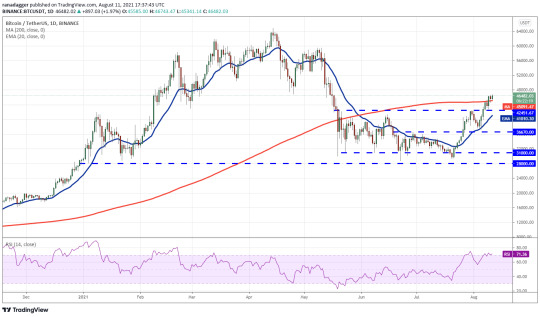
BTC / USDT daily chart. Source: TradingView
The 20-day exponential moving average (41,010) is up and the relative strength index (RSI) is in the overbought territory, suggesting the bulls are in control.
If buyers drive the price above $ 46,700, the BTC / USDT pair will likely begin its journey towards the $ 50,000 to $ 51,500 resistance zone. The bears will try to stop the rally in this zone, but if the bulls can meet the challenge the pair could rise to $ 60,000.
If bears pull price back below the 200-day SMA, the pair could fall to the 20-day EMA. If the price recovers from the 20-day EMA, the bulls will make another attempt to start the uptrend.
Conversely, a break below the 20-day EMA could open the doors for a drop to the nearest support at $ 36,670. This is an important level for the cops to defend because when it cracks the bears will sense an opportunity.
ETH / USDT
The strong rally in Ether (ETH) on August 9th shows that the bulls have flipped the $ 3,000 mark into support. This level is likely to serve as a floor for future declines.

ETH / USDT daily chart. Source: TradingView
The bulls are trying to resume the uptrend today. The ETH / USDT pair could now rebound into the resistance zone of $ 3.4441.73 to $ 3,587.06 where the bears are likely to be a major challenge.
If the price drops down from this zone but rebounds from $ 3,000, it suggests that the bulls are buying on dips. That will improve the chances of a rally to $ 4,000.
Alternatively, if bears pull price below the 20-day EMA ($ 2,712), it suggests that the current breakout was a bull trap. The pair could then fall to the 200-day SMA ($ 2,229).
BNB / USDT
Binance Coin (BNB) rebounded from the moving averages on August 9 and began its upward journey towards the resistance of the large range of $ 211.70 to $ 433. The bears are likely to aggressively defend the $ 433 level.

BNB / USDT daily chart. Source: TradingView
However, unless the bulls give up much near the $ 433 mark or buy the drops to the 20-day EMA ($ 338), the likelihood of a break above $ 433 increases. If so, the BNB / USDT pair could rise to $ 520 and then to $ 600 later.
On the contrary, if the price drops from current levels or from overhead resistance and falls below the $ 340 mark, it suggests that the range action could continue for a few more days.
ADA / USDT
The bears attempted to stop the Cardano (ADA) relief rally at the USD 1.50 resistance but failed to pull the price back below the 20-day EMA (USD 1.42). This indicated that the bulls were not posting gains as they expected the rally to continue.
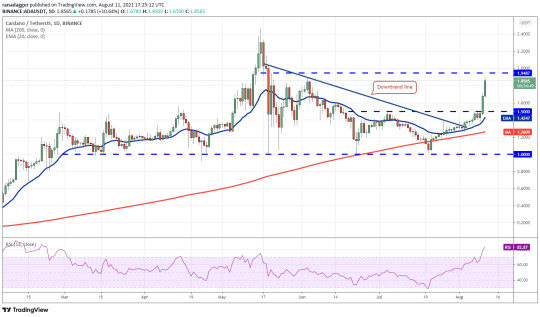
ADA / USDT daily chart. Source: TradingView
The ADA / USDT pair rose above $ 1.50 on August 10 and may now rebound to overhead resistance at $ 1.94. This level could attract profit bookings and if the price deviates the bears will attempt to pull the price back to $ 1.50.
In this case, the couple could extend their range promotion by a few days. On the contrary, if the bulls push the price above $ 1.94, the pair could challenge the all-time high of $ 2.47. A breakout and a close above this level indicate a resumption of the uptrend.
XRP / USDT
The bulls successfully retested the breakout level at $ 0.75 on August 9, pushing XRP back above the 200-day SMA ($ 0.80). The altcoin could now rebound to the downtrendline of the descending channel, where the bears could build stiff resistance.
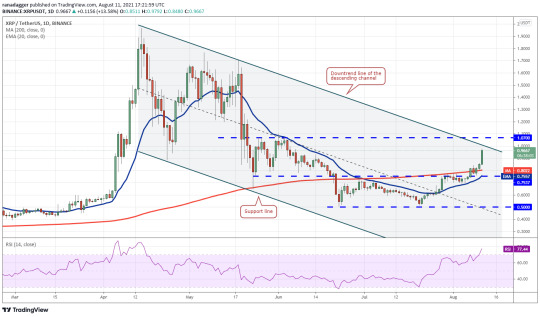
XRP / USDT daily chart. Source: TradingView
If price turns down from the downtrendline but rebounds from the 20-day EMA ($ 0.75), it suggests that bulls are buying on dips. A breakout and close above the descending channel signal a possible trend reversal.
The initial upside target is at $ 1.07 and if the bulls push the price above this resistance the upside move could hit $ 1.26. Alternatively, if the price drops from the current level or the downtrend line and falls below $ 0.69, it indicates that the downtrend remains intact.
DOGE / USDT
Dogecoin (DOGE) moved down from the overhead resistance at $ 0.29 on August 8, but the correction was short-lived as the price rallied again on August 9. The bulls will now try to push the price above the overhead resistance.

DOGE / USDT daily chart. Source: TradingView
If successful, the DOGE / USDT pair could rise to $ 0.35. This level can act as strong resistance, but if the bulls break this hurdle, the upside move could hit $ 0.45. The 20-day EMA ($ 0.22) has started to move higher and the RSI is just below the overbought zone, suggesting that the path of least resistance is up.
On the flip side, the pair could fall to the 20-day EMA if the price moves down from $ 0.29. If price bounces off this support, the bulls will make another attempt to push the price above $ 0.29. Conversely, a break below the 20-day EMA could hold the pair between $ 0.21 and $ 0.29 for a few days.
DOT / USDT
The bears have been trying to stop the polkadot (DOT) rebound from overhead resistance at USD 21 for the past few days, but the bulls haven’t given up much ground. This suggests that bulls will buy on every small decline.
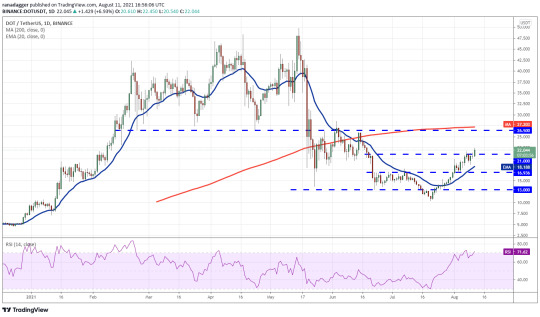
DOT / USDT daily chart. Source: TradingView
The rising 20-day EMA ($ 18.18) and the RSI in the overbought territory suggest that the bulls are in control. If buyers hold the price above $ 21, the DOT / USDT pair could begin its journey to overhead resistance at $ 26.50.
If the price goes down from $ 26.50, the pair could drop to $ 21 and stay between those two levels. A breakout and close above $ 26.50 indicates the beginning of a new uptrend that could hit $ 31.28. The bears will have to pull the price back below $ 16.93 to take the advantage in their favor.
UNI / USDT
Uniswap (UNI) moved down from the overhead resistance at USD 30 on Aug 10, but the bears were unable to sustain the lower levels. This suggests that bulls will buy on every small decline.

UNI / USDT daily chart. Source: TradingView
If the bulls push the price above $ 30 and close, the UNI / USDT pair could begin its march north towards $ 37. A break above this resistance could open the way for a retest of the all-time high at $ 45.
However, the RSI is in the overbought territory, suggesting that the rally could be overdrawn in the short term. This could pull back on the 200-day SMA ($ 26). A strong rebound from this support will suggest that the bulls are in charge. The bears will have to pull and hold the price below $ 23.45 to get the upper hand.
Related: The downturn in the US dollar is helping Bitcoin bulls ahead of the BTC price showdown of $ 50,000
LINK / USDT
The recovery rally at Chainlink (LINK) has reached the critical overhead resistance zone at $ 26.48 and the 200-day SMA ($ 27.86) where the bears are likely to be a major challenge.

LINK / USDT daily chart. Source: TradingView
If the price moves down out of this zone, the LINK / USDT pair could fall again to the 20-day EMA (USD 22.37). A strong rebound from this support will suggest that sentiment has turned positive and the bulls will then make another attempt to break the overhead hurdle.
A breakout and close above the 200-day SMA suggests the bears have lost their grip. The pair could then rise to $ 32 and later to $ 35.33. Conversely, a break and close below the USD 22.07 support suggests that bullish momentum has weakened.
SOL / USDT
The bears’ failure to keep Solana (SOL) below $ 38.10 on August 9 sparked further buying, pushing the price to overhead resistance at $ 44.

SOL / USDT daily chart. Source: TradingView
If the bulls push the price above $ 44, the SOL / USDT pair could rise to psychological resistance at $ 50 and then retest the all-time high at $ 58.38. A breakout and close above this resistance signals the resumption of the uptrend.
The rising 20-day EMA ($ 35.59) and the RSI in the overbought territory suggest that the bulls have the upper hand. This positive view will be invalidated if the price drops from current levels and falls below the 20-day EMA. That could push the price down to $ 32 and then down to the 200-day SMA ($ 26.81).
The views and opinions expressed herein are solely those of the author and do not necessarily reflect the views of Cointelegraph. Every investment and trading movement carries risks. You should do your own research when making a decision.
Market data is provided by HitBTC Exchange.
#movingaverage #themarket


0 notes
Text
Is the cryptocurrency epicenter moving away from East Asia? – Cointelegraph Magazine
It probably came as little surprise last year when crypto intelligence firm Chainalysis declared East Asia “the world’s largest cryptocurrency market,” accounting for 31% of all cryptocurrency transacted during the previous 12 months. The region has a broad base of retail users along with a solid foundation of crypto traders and institutions, and China alone was at the time mining around two-thirds of all the Bitcoin in the world.
In July 2021, Fidelity Digital Assets surveyed 1,100 institutional investors in the United States (408), Europe (393) and Asia (299) between December 2, 2020 and April 2, 2021. The study reinforced this idea, with the firm reporting that digital asset adoption rates are substantially higher in Asia (71%) than in Europe (56%) and the United States (33%). In March 2021, a Statista consumer survey of 74 countries on cryptocurrency ownership and usage determined that the Asian nations of Vietnam and the Philippines are ranked second and third globally, respectively.
But the past is not always a prelude to the future, and there is no guarantee that East Asia will remain the world’s center of gravity for crypto adoption. China’s attachment to crypto is tenuous at best, and Beijing’s rollout of its digital yuan could cause reverberations throughout the region.
When asked about the crypto prospects of East Asia, Kim Grauer, head of research at Chainalysis, tells Magazine that the region has recently experienced “a major decline in cryptocurrency adoption compared with other regions globally,” further adding:
“This drop-off is driven by a decline in Chinese activity beginning 6 months ago, which coincided with various crackdowns there including the mining ban and the halting of derivatives trading by major exchanges. We hypothesize that much of this activity has migrated to DeFi, but that hasn’t picked up enough that it makes up for the losses in the derivatives market yet.”
China’s dominance in Bitcoin mining made it “a natural marketplace for crypto,” says Lennard Neo, head of research at Stack Funds. But as reported, many rigs are moving elsewhere, including to Canada, Kazakhstan, Russia and the United States.
Asked if Asia is likely to maintain its crypto dominance, Eloisa Cadenas, CEO of Mexico-based financial services firm CryptoFintech, tells Magazine: “It is a difficult question to answer because, when we think of Asia, we automatically focus our attention on China which, as we know, has taken quite restrictive measures in relation to Bitcoin, crypto assets and of course, mining.”
China’s digital yuan is likely to have a big impact on the region, Cadenas says. Indeed, she anticipates that other Asian countries will try to replicate the digital yuan model, and “It is likely that there is also an intention to block or restrict the market for crypto assets in such a way that only the CBDCs of each country can proliferate.”
If that happens, the mass center of crypto adoption could move elsewhere — to Latin America or Africa, opines Cadenas. These are two regions where, according to her, there is “a greater possibility of adoption, since the economic, social and political context is different.”
Asia’s crypto crown could indeed be in play now, as Latin America and Africa aren’t the only contenders. Here’s who could potentially fill the void if and when Asia falters:
North America
Traditional “reticence” on the matter of digital assets is the result of three principal factors, according to another report by Fidelity Digital Assets: price volatility, concerns around market manipulation, and the lack of fundamentals to gauge appropriate value. But U.S. respondents appear to be coming to grips with digital assets, despite these shortcomings.
“The strength of concerns [in the U.S.] decreased notably vs. last year across most factors,” reported Fidelity Digital Assets. “Price volatility concern fell 13 points, concerns around market manipulation fell 6 points and lack of fundamentals fell 8 points.”
Elsewhere, some of the United States’ top legacy banks — including State Street, BNY Mellon, JPMorgan Chase, Citigroup and Goldman Sachs — have been making forays into the crypto space.
On the mining front, the U.S. was already the number-two mining nation before China’s May crackdown on crypto mining, albeit a distant second. Back in September 2019, China contributed 75.53% of the global Bitcoin hash rate. But more recently, China’s portion of the hash rate has ebbed to 46.04%, while the U.S. has broadened its share to 16.85% globally. Henri Arslanian, crypto leader and partner at advisory firm PwC, tells Magazine:
“The United States is probably the one country that has a lot of momentum now. The regulations are becoming clearer, there are numerous large crypto companies and there is a lot of capital flowing into crypto both from institutional investors and retail.”
Meanwhile, north of the U.S. border, Canada has been innovating on the crypto front. The Purpose Bitcoin ETF, North America’s first crypto-based exchange-traded fund, launched in February and has been a big hit by most accounts. It was followed in April by an Ether ETF, with strong volumes reported.
Many believe that it’s only a matter of time before Canada, with its vast hydroelectric resources, becomes a major player in crypto mining, particularly as more miners seek out renewable energy sources to power their rigs.
Latin America
The Latin American region could become a crypto adoption hotspot, and not only because El Salvador declared Bitcoin legal tender in June when it issued its Bitcoin Law — a historic move in the view of some.
Many regional economies are sustained by remittances — i.e., money sent home from workers abroad. They account for 23% of El Salvador’s gross domestic product, for instance. In Honduras, remittances also exceeded 20% of the gross national product in 2019, according to Pew Research Center. By comparison, Mexico saw only a 3% share of its GDP driven by remittances, but its gross numbers are high — $42.9 billion in 2020, according to the World Bank, which is a number behind only China and India. Crypto and blockchain technology potentially offer a more efficient way to transfer overseas payments.
The trend in Latin America “is toward retailers and unbanked users because with cryptocurrencies you can create cheaper financial products that, eventually, could promote greater financial inclusion,” CryptoFintech’s Cadenas tells Magazine.
There is also evidence that El Salvador’s dramatic action may be encouraging other countries in the region to devise their own crypto strategies. Paraguayan legislators introduced a cryptocurrency bill to the nation’s Congress in July, for instance.
“Where El Salvador has led, we can expect other developing countries to follow,” said Nigel Green, CEO and founder of financial service company deVere Group. “This is because low-income countries have long suffered because their currencies are weak and extremely vulnerable to market changes and that triggers rampant inflation,”
There isn’t much CBDC fervor in the region either, which means that Latin American countries are less likely to clamp down on crypto for competing with a government’s digital currency. “What I do see [in Latin America] is financial institutions creating alliances with crypto-asset companies to facilitate operations through crypto-assets, mainly with stablecoins,” Cadenas says.
Stack Funds’ Neo perceives some similarities between Latin America and Asia. The latter was historically home to a number of “restricted” currencies that were subject to government controls — such as the Chinese yuan, Indian rupee, Indonesian rupiah, Malaysian ringgit and Philippine peso — making them difficult to convert. These restrictions encouraged investors to turn to crypto “as a hedge against these limitations,” explains Neo. Similar tendencies may be emerging in Latin America where citizens increasingly appear to “prefer crypto over fiat [currencies], which are exacerbated by political turmoil.”
In its “2020 Geography of Cryptocurrency Report,” Chainalysis cites Venezuela — which ranked third globally out of 154 countries in its Global Crypto Adoption Index — as a stellar example “of what drives cryptocurrency adoption in developing countries and how citizens use it to mitigate economic instability,” adding that “Venezuelans use cryptocurrency more when the country’s native fiat currency is losing value to inflation, suggesting that Venezuelans turn to cryptocurrency to preserve savings they may otherwise lose.” Chainalysis saw the same pattern in other Latin American countries, as well as those in Africa and East Asia.
Cryptocurrency adoption in the region may not all go according to plan, of course. Eric Anziani, chief operating officer of cryptocurrency exchange Crypto.com, tells Magazine that “El Salvador officially accepted Bitcoin as legal tender, but this news is a two-edged sword. If the experiment is successful, then it will promote crypto in the region; otherwise, it could make local governments look at cryptocurrencies with greater skepticism.”
Europe
As in North America, institutional interest in crypto is growing in Europe. Today, nearly 80% of institutional investors “believe digital assets should be part of a portfolio,” according to Fidelity Digital Asset’s July report. And while “this belief is strongest in Asia,” it is also strong and growing in Europe: “More than three-quarters (77%) of European investors share this belief, up from two-thirds the prior year.”
The European Commission’s proposed Markets in Crypto Assets (MiCA) regulation, undergoing its first reading in the European Parliament, is expected to create a harmonized European crypto-asset market that “will definitely attract more and more large institutional investors — hedge funds, pension funds etc. — that have been wary of investing in this asset class due to regulatory concerns,” says Patrick Hansen, head of blockchain at Bitkom, an association of German companies in the digital economy.
When MiCA is implemented, a crypto firm receiving authorization from any one of the 27 European Union countries will be able to share its services across all the other EU states. Hansen also foresees greater mainstream adoption in the region and among its 450 million residents.
On the flip side, the European Central Bank is moving ahead with plans to introduce a digital euro that could be used by the 19 countries in the eurozone as “an alternative to third-party payment services and cryptocurrencies like Bitcoin,” reported Deutsche Welle, mainly because “Central bankers fear the widespread use of foreign or unregulated currencies could destabilize the economy.”
In other words, Europe’s crypto-wary central bankers could still have something to say about crypto adoption in the region.
Africa
When focusing on retail adoption, regions in the developing world such as Africa can’t be overlooked, Monica Singer, ConsenSys’ South Africa lead, tells Magazine. “Nigeria has one of the highest numbers of retail users of Bitcoin,” for instance — at least on a per capita basis. It ranks first among 74 countries in Statista’s March consumer adoption survey. She further adds:
“In countries where there is no trust in the fiat currency, and the population is young and mostly all have access to the internet, it is a natural progression that they will use cryptocurrencies to transact, in particular for remittances.”
Three African nations — Kenya, Nigeria and South Africa — made the top 10 in Chainalysis’ 2020 global crypto adoption index. “Remittances are an early use case for this developing cryptocurrency economy,” notes the report, adding that many of the region’s countries are also plagued by severe currency devaluation and instability, making them ripe for Bitcoin and its fixed, anti-inflationary supply.
Still, many African countries have restrictive policies with regard to currencies not backed by central banks, which could impede adoption, Singer tells Magazine. In early 2021, Nigeria’s central bank effectively banned commercial banks from providing account services to crypto exchanges.
The dominant mood is optimism, though, as epitomized by Cardano founder Charles Hoskinson’s keynote address at Blockchain Africa in which he compared Africa’s emerging economy to China in the 1980s — both offering case studies of new technologies leapfrogging legacy systems. Indeed, Hoskinson predicted: “There’s a great potential for that to be African nations — not Germany, not France, not England, not the United States, not China or Japan.”
East Asia
Of course, there are good reasons that nothing much may change at all — and East Asia remains crypto’s adoption epicenter. Asian countries have embraced digitalization, while their appetite for crypto was whetted by their early exposure to pioneering crypto firms. Indeed, by the end of 2020, six of the 10 largest crypto “unicorns” were Asia-based — including Bitmain, Binance, OKEx, Huobi, BitMEX and FTX.
Moreover, many East Asian nations that have embraced e-payments are used to public market investing and encourage STEM subjects in their school systems. Charles d’Haussy, managing director of the Asia-Pacific region at ConsenSys, tells Magazine that Asia’s “new wealth,” as well, is keener to embrace new asset classes, compared with “established wealth in the Western World which is more drawn to traditional asset classes.” For these reasons, he concludes that “Asia has a head start and will remain a leader [in crypto] for the decades to come.”
Even without China, Asia may be deep enough with regard to crypto adoption that it won’t lose its leadership position. Winston Ma, adjunct professor at New York University School of Law and author of The Digital War: How China’s Tech Power Shapes the Future of AI, Blockchain and Cyberspace, tells Magazine:
“Asian investors are used to inflation risk in their economies and high volatility in trading markets, and they embraced digital assets to hedge against the fiat money printing across the globe.”
“The lead may shift from China to Southeast Asian countries, as well as other countries with less restrictive regulations and laws with regard to crypto,” Yu Xiong, international associate dean at Surrey University and chair of business analytics at Surrey Business School, tells Magazine. In addition, Hansen notes that crypto-favorable regulatory frameworks have emerged in Singapore, Hong Kong and Japan.
Meanwhile, on the institutional front, “Regulatory clarity and tax treatment of crypto markets relative to their other options — stocks, derivatives, etc. — will matter a great deal more than it does for retail investors,” says Gina Pieters, assistant instructional professor in the Department of Economics at the University of Chicago. Here again, East Asia often seems further advanced than other regions. Pieters adds:
“Japan’s tax treatment of gains from crypto investment is much simpler than USA tax treatment, and so all else equal it would not be surprising to see higher adoption in Japan by institutional investors compared to the USA.”
Overall, if one were to categorize the competition, it would be the history, culture, professional traders, exchanges and first-mover advantage of Asia pitted against the youth and economic needs of Latin America and Africa, the investment capital and entrepreneurial vitality of North America, and the wealth, size and regulatory harmonization of Europe.
Who will prevail?
The case could be for Latin America or Africa, where the need is the greatest and a clear solution seems at hand. But, of course, it’s really anyone’s guess.
4 notes
·
View notes
Text
BTC, ETH, BNB, ADA, XRP, DOGE, DOT, UNI, BCH, LINK
Bitcoin’s (BTC) rebound from $ 29,482.61 on July 21 has continued to break resistance after resistance. Today, Bitcoin has risen above the simple 200-day moving average, an indicator that institutional investors watch to determine whether the asset is bullish or bearish.
One positive sign of today’s rally was that Bitcoin was not affected by the flash crash in gold, which temporarily fell to a four-month low. This suggests that traders are focusing on the fundamentals of the sector rather than being affected by the performance of other asset classes.
Daily performance of the cryptocurrency market. Source: Coin360
Glassnode noted that investors who have held Bitcoin for more than a year have not reduced their positions to $ 45,000 after the recent rally. This is in contrast to the 2018 bear market, “where old hands took exit liquidity from most relief rallies”.
Will Bitcoin enter a bull phase and pull the sector up? Let’s check out the top 10 cryptocurrency charts to find out.
BTC / USDT
Bitcoin’s breakout above the overhead resistance at $ 45,451.67 hit a wall at the 200-day SMA ($ 44,954) on Aug. 7.
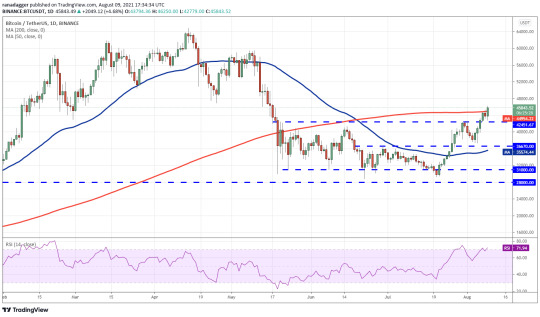
BTC / USDT daily chart. Source: TradingView
The BTC / USDT pair rebounded from the $ 42,451.67 level today and the bulls pushed the price above the 200-day SMA. If buyers hold the price above the 200-day SMA, it signals an end to the downtrend.
The pair could then rebound to the overhead resistance zone at $ 50,000- $ 51,500, where the bears could build tough resistance.
If the price falls off this zone but stays above the 200-day SMA, it increases the possibility of the upward move continuing. A break above $ 51,500 could pave the way for a rally to $ 60,000.
This upward move will be voided in the short term if the price goes down and falls below the breakout level of $ 42,451.67. The pair could then fall to the nearest support at $ 36,670.
ETH / USDT
Ether (ETH) rose above the $ 3,000 psychological level on August 7, suggesting the correction may be over. The bears tried to trap the aggressive bulls by pushing the price back below $ 3,000, but buyers held off.

ETH / USDT daily chart. Source: TradingView
The bulls will now try to continue the uptrend and push the price down to $ 3,500 and then to the psychological resistance at $ 4,000. However, the sharp rally of the past few days has pushed the relative strength index (RSI) into overbought territory.
This suggests the rally has overheated in the short term and a consolidation or correction is possible. The first sign of weakness will be a breakout and a close below $ 2,893.23. This could lead to a drop to $ 2,500.
BNB / USDT
Binance Coin (BNB) broke and closed above the USD 340 resistance on August 6, completing a bullish ascending triangle pattern. The bears tried to push the price back below the breakout level, but the altcoin bounced off the 200-day SMA ($ 328) today. This suggests that bulls are buying dips.

BNB / USDT daily chart. Source: TradingView
The BNB / USDT pair may now begin its march towards the overhead resistance at USD 433. The bears should again defend this level strongly.
If the price deviates, the pair could drop to $ 340 and stay in the range for a few days. A dip and close below the 50-day SMA ($ 308) could tip the advantage in favor of the bears.
On the other hand, a breakout and a close above $ 433 suggests the correction is over. The pair could then attempt a new uptrend that could hit $ 520.
ADA / USDT
Cardano (ADA) was down from $ 1.50 on August 8, but the bulls are in no mood to give way. They bought the dip and are currently trying to push the price back above the overhead resistance.
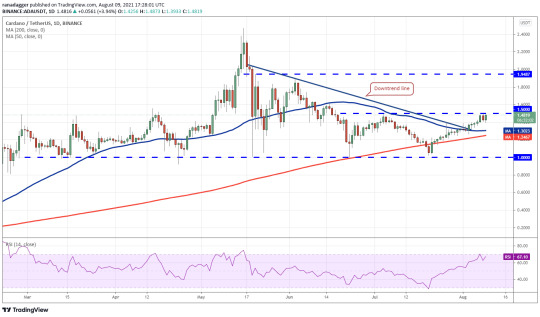
ADA / USDT daily chart. Source: TradingView
If buyers push the price above $ 1.50, the ADA / USDT pair could begin its march north towards the overhead resistance at $ 1.94. This level can act as strong resistance, but unless the bulls give up much ground the pair could continue on its upward trajectory.
Conversely, if the price drops from $ 1.50, the pair could fall to the moving averages. A break and close below the moving averages signal that the bulls are losing their grip. The pair could then fall to the critical $ 1 support.
XRP / USDT
XRP climbed above the $ 0.75 resistance and the 200-day SMA ($ 0.79) on August 7, completing a double bottom pattern. The price rebounded from the breakout levels today, suggesting that the bulls flipped levels in support.
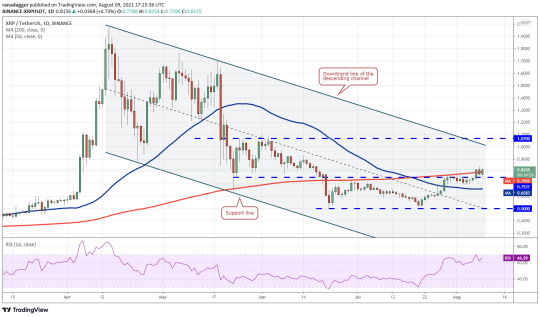
XRP / USDT daily chart. Source: TradingView
If buyers push the price above $ 0.84, the XRP / USDT pair could begin its journey towards the overhead resistance zone at $ 1-1.07. A breakout and close above this zone could signal the start of a new uptrend.
Alternatively, the pair could fall to the 200-day SMA if the price deviates from the overhead resistance. A rebound from this support could hold the pair between $ 1.07 and $ 0.75 for a few days. The bears will have to pull the price below the 50-day SMA ($ 0.65) to get the upper hand.
DOGE / USDT
Dogecoin (DOGE) consolidation near the overhead resistance at $ 0.21 broke up on Aug 7 as the bulls consolidated their supremacy. The bears were a big challenge on August 8th at $ 0.29, but the positive sign is that the bulls did not drop the price below $ 0.21.
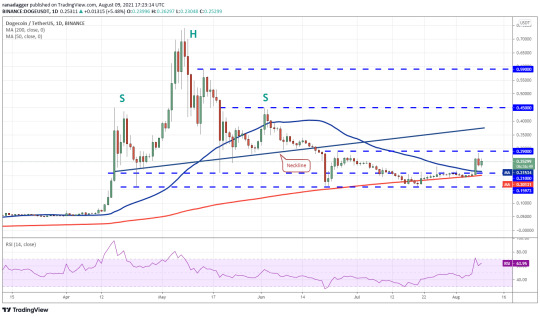
DOGE / USDT daily chart. Source: TradingView
Buyers will now make another attempt to push the price above $ 0.29. If that happens, the DOGE / USDT could rise to $ 0.35 where the bears could build strong resistance again.
On the contrary, if the price goes down from $ 0.29, the pair could drop to $ 0.21 and stay between these two levels for a few days. A break and close below the 200-day SMA ($ 0.20) could lower the pair to the critical support at $ 0.15.
DOT / USDT
Polkadot (DOT) faces strong resistance at the overhead resistance at $ 21, but the positive sign is that the bulls haven’t given up much ground. This suggests that the bulls are not closing their positions as they expect the rally to continue.
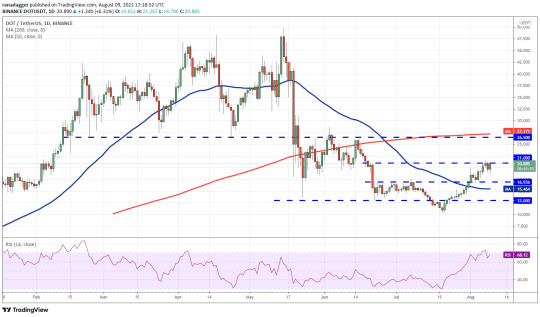
DOT / USDT daily chart. Source: TradingView
If the bulls push price above the overhead resistance at USD 21, the DOT / USDT pair could begin its journey to the next target at USD 26.50. The 200-day SMA ($ 27) is just above this resistance, so the bears are likely to aggressively defend this level.
If the price deviates from this resistance, the pair could fall to $ 21. A strong rebound from this level suggests traders buy on dips. Conversely, a break below $ 21 could bring the price down to the 50-day SMA ($ 15.46).
UNI / USDT
Uniswap (UNI) broke the 200-day SMA (US $ 25.81) on August 6th and the bulls successfully defended retest of the level on August 8th. This suggests that the 200-day SMA will now act as support on future declines.

UNI / USDT daily chart. Source: TradingView
Buyers will now try to push the price above the overhead resistance at $ 30. If they do that, it will indicate that the downtrend is over. The UNI / USDT pair could then begin its journey at $ 37 and later at $ 44.
Contrary to this assumption, if the price goes down from $ 30, the pair could fall back to the 200-day SMA. A break below this support suggests the bulls may lose their footing. The pair can then drop to $ 23.45.
Related: Ethereum could pave the way for $ 100,000 Bitcoin, claims Bloomberg analyst
BCH / USDT
Bitcoin Cash (BCH) broke the USD 546.83 resistance on August 6, completing the double bottom pattern. The bulls have successfully held breakout levels for the past two days which is a positive sign.

BCH / USDT daily chart. Source: TradingView
The BCH / USDT pair could now move to the 200-day SMA ($ 639) where the bulls could face strong resistance again. A breakout and a close above this level could pave the way for the pair to rally to the pattern target at $ 710.13.
Contrary to this assumption, if the price deviates from the 200-day SMA, the pair could fluctuate between the moving averages for a few days. A break below the 50-day SMA (493) could increase the likelihood of a decline to $ 450.
LINK / USDT
The bears attempted to pull Chainlink (LINK) back below the breakout level of $ 22.07 on August 8, but failed. This suggests that sentiment has turned positive and traders buy on dips.
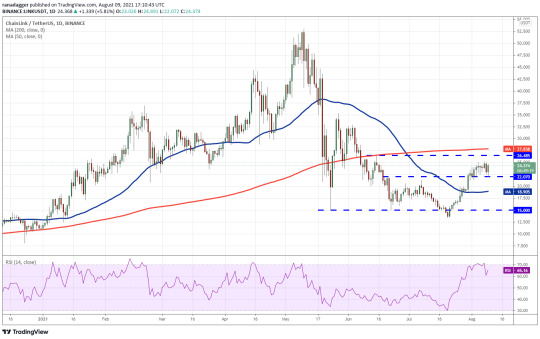
LINK / USDT daily chart. Source: TradingView
The bulls will now seek to push the price down to the overhead resistance at $ 26.48 where the bears could build up stiff resistance again. If the price moves down from this level, the LINK / USDT pair could stay in a range between $ 26.48 and $ 22.07 for a few days.
A breakout and close above the 200-day SMA (USD 27.83) signals an end to the downtrend. The pair could then rise to $ 32 and later to $ 35.33. On the flip side, a break below $ 22.07 could pull the 50-day SMA ($ 18.90) down.
The views and opinions expressed are those of the author only and do not necessarily reflect the views of Cointelegraph. Every investment and trading movement involves risks. You should do your own research when making a decision.
Market data is provided by HitBTC Exchange.
0 notes
Text
Tracking sperm on Bitcoin with Eggschain — Wei Escala – Cointelegraph Magazine
What if sperm were uploaded – or maybe, uh, discharged – onto the Bitcoin network and those looking to get pregnant could more easily access the emotional, complex task of finding the right swimmers on the blockchain for attributes like Choose education? Level, hobbies and physical characteristics?
Wei Escala is the founder and CEO of Egg chain, an Austin-based startup developing a supply chain solution for the assisted reproduction industry. In vitro fertilization (IVF) involves implanting a fertilized egg in a woman’s ovaries to induce pregnancy. This requires sperm, sometimes provided by a partner and sometimes by a donor.
It’s part of a new kind of project built on stacks, a blockchain that shares a native connection with Bitcoin via proof of transmission, what “enables decentralized apps, smart contracts and digital assets” completed and verified on Bitcoin blocks. Eggschain is one of these new decentralized apps or DApps.
But why do sperm donations and embryo implantations have to be registered in a blockchain first? The answers lie in the scalability for a seamless sperm selection process across different jurisdictions, not to mention a high level of protection for patient data, protection against data loss or incorrect storage and an overall more transparent design of the system.
If things go well, Eggshain’s blockchain-based matching solution could soon bear fruit around the world. It’s not there yet, but it is revolution comes.
Egg chain
Eggschain’s blockchain is secured by Bitcoin via stack, a startup incubated by Y Combinator that is “building a Bitcoin-secured Internet owned by the user”. In practice, this means that Stacks operationalizes smart contracts and DApps like Eggschain by syncing with Bitcoin every 10-minute block to embed an indelible, permanent record.
Dear community, the moment we’ve all been waiting for.
We couldn’t be happier to announce our first cohort of 25 startups building on Bitcoin with stacks.
https://t.co/2iZ1kOiGhy
– startups.btc (@StacksStartups) June 23, 2021
The Eggschain solution has not yet been published. “I don’t want to commit myself to a schedule,” says Escala, also because “we are among the first developers to build on the Stacks blockchain.” This seems like a reasonable answer, as there are often delays in blockchain projects comes – be it due to technical, legal or budgetary challenges.
While lower transaction fees influenced the decision to build on a Bitcoin sidechain instead of other chains like Ethereum, Bitcoin’s reputation as an incorruptible ledger was crucial. Bitcoin “will be around for hundreds, thousands, or millions of years,” says Escala, as if stating some basic scientific fact. While millions of years can be written off as overzealous marketing, choosing a chain to pursue reproduction means to support the one most likely to survive far into the future.
“Bitcoin is the oldest blockchain in the world and very well established, and gas fees are many times lower compared to some of the other leading blockchains.”
Escala explains, “When your semen is donated, it is a transaction that is hashed on the blockchain,” complete with an indelible timestamp. Other transactions take place “when the sperm is implanted in a woman or an egg”. The time between fertilization of the egg and implantation can go on for years and the sperm have become held frozen for as long 22 years and has still been used successfully.
In practice, this means that a donor can see how often their sperm has been used, which gives them a rough idea of how many children they could have and in what general areas. This can even serve to gamify the sperm donation experience even if the donor is unwilling to be contacted by his offspring ever.
Although Bitcoin itself is a transparent blockchain that allows transactions to be tracked, Escala explains that, like stacks, Eggschain cannot be “retraced” in such a way that the “family tree” can be followed up and down. This is by design because “Just because someone received your donated semen doesn’t give them the authority to read your life – it’s almost an invasion of your privacy,” says Escala.
“Patient-identifiable information cannot be on the blockchain.”
Freezing desire
In India and much of Africa, it is normal for women to have their first baby at the age of 20. At the age of 25 in the USA represents the lowest Average age in the western world, with the average primipara in countries like Germany, Singapore, Japan, Great Britain and Australia flirting or even exceeding 30 – the age at which fertility begins to decline.
Although access to contraception and changing values contribute to old age in the West, careers and finances often play a role. The pressure to postpone pregnancy is all the greater as professional development often requires frequent moves between offices and countries – although the homework era may bring changes.
Health problems like cancer, that is increasing globally, is another driver of treatment as women try to preserve their eggs before chemotherapy can harm them. All in all, it’s easy to see why so many women choose to do this freeze their eggs – just in case they deteriorate or run out before they want to use them.
The Eqq quality starts to decrease at 30 and quickly decreases from 35. Source: She worries
When her best friend decided to freeze her balls in 2018, Escala “witnessed every step – I felt like I almost lived through the whole experience.” Not just a friend, she’s also a businesswoman, and she sensed an opportunity to improve the IVF process.
Escala founded Eggschain in June 2018.
Breeding process
Unless there is a pre-selected partner, the process of sperm selection – or more precisely, a sperm donor – is an intimate and difficult process. On the one hand, donors have to be examined in “an established laboratory for sexually transmitted diseases, HIV and all hereditary diseases”, and their sperm are often kept in quarantine for up to six months.
Depending on the sperm bank and the laws of the donor’s country, there is often extensive information about the potential donor, such as educational level, hobbies and physical characteristics – all these attributes that are connected to the given semen sample via Eggschain.
“I can say that I want a sperm donor with curly hair and maybe a college degree – and that sperm donor ideally plays the violin,” explains Escala, listing attributes that can often be selected for. She also suggests that someone who likes basketball could choose a “size” donor who plays basketball.
All of these anonymous attributes can be added to the blockchain and effectively become the “statistics” of the specific sperm, making choosing a sperm a smoother experience. While not remotely comparable to any serious medical procedure, the chain’s function bears a metaphorical resemblance to certain ones NFT based gameswhere the characters “DNA” is tracked on the blockchain as it is passed on to “descendants”. The ethical implications of choosing designer babies are likely to be left to the users with whom to wrestle.
Axie Infinity is a game in which “Axies” pass on their genetics. Source: Axie Infinity
Corporate travel
Escala doesn’t live up to the stereotype of a hip cowboy blockchain entrepreneur. Despite having had a career in marketing “and much in the supply chain,” she presents herself as a meticulous scientist who is careful with definitions and technical details – even a nerd.
She was born in Austin, Texas and moved to Singapore when she was 15. There she attended Temasek Junior College, where she studied physics, math and organic chemistry before returning to Austin “to be closer to my good friends and to join the hustle and bustle”. Startup scene there. ”She enrolled in a computer science program at the University of Texas at Austin, where she became interested in cryptography and human-machine interaction.
“I graduated right after 9/11, so some of my offers were withdrawn,” she recalls. Despite the turmoil, she worked as a stockbroker and financial advisor at American Express in Salt Lake City, Utah, until March 2002. She also worked as a branch manager for SunTrust Bank in Hampton, Virginia.
Not entirely satisfied with her career in finance, Escala completed an MBA in Marketing, Strategy and General Management from Goizueta Business School at Emory University in Atlanta. This was followed by 15 years of career growth in companies where Escala shuttled between cities in the continental United States, holding most of the jobs for a year or two.
Ohio. New York. Texas. Ohio. Kentucky.
And back to Austin, Texas in 2017. There she worked as the CEO of Powerista, which could help anyone “create a website in less than 2 minutes!” It didn’t last, but is still used by someone with obvious marketing skills marketed.
Great Selling Proposition!
In Austin in 2018, Escala came across blockchain at a South by Southwest conference and immediately saw an application to track biosamples for personalized medicine.
Come revolution
According to Escala’s vision, sperm banks all over the world could be connected to the Eggschain backend – practically the front end or the user interface of the sperm donation. In theory, this could allow patients to have a much wider variety of spermatozoa. The laws of different jurisdictions could also be programmed into the chain, effectively minimizing the legal bureaucracy of international inseminations.
Due to the scalability potential after the implementation of the system, Eggschain has set its goals high. “We hope to make a universal tracking system available to all patients in the world,” says Escala of everyone involved in the IVF process.
Since Eggschain’s “patented solution involves matching and tracking genetic material using the blockchain,” it means that sperm and embryos are only the tip of the iceberg when it comes to possible uses for Eggschain in the future.
“Organs, tissue and other bio-samples can definitely use the system in the future,” says Escala optimistically.
0 notes
Text
An Ethereum blockchain upgrade, crypto regulatory battles, and Bitcoin price discussion: Hodler’s Digest, Aug. 1-7
Hodler’s Digest comes every Saturday and helps you keep track of every single important message that happened this week. The best (and worst) quotes, introductory and regulatory highlights, leading coins, predictions, and more – one week on Cointelegraph in one link.
This week’s top stories
Square is acquiring Australian fintech Afterpay in a $ 29 billion deal
Jack Dorsey’s digital payments company Square signed a $ 29 billion share agreement this week to buy and pay Australian company Afterpay (BNPL) now.
Just like the name Afterpay implies that Square will essentially buy the company now and pay for it later, with the transaction slated for the first quarter of 2022 and paid entirely in Square common stock.
Bitcoin (BTC) Advocate Anthony Pompliano was pleased with the news and noted on his web series The best business show that Square is one of the few stocks he owns since he predicted the Value will explode after the takeover.
In an August 3 YouTube video, Pomp chose pure clickbait titled, “SQUARE Will Be Worth $ 1 Trillion,” highlighting the potential of rollout of Afterpay’s BNPL services to 70 million cash app users and 2 million square Dealers.
Ethereum London Hard Fork goes live
The London hard fork arrived almost on schedule on August 5th and initiated the Ethereum Improvement Proposal in 1559. An interesting feature of the upgrade is that it also has some bullish sentiments from Ethereum (ETH) Advocates and some sour grapes from Bitcoin maxis.
Ethereum has now moved from a bid-based fee market to a fixed-price-and-burn mechanism that can cause the asset to become deflationary if more ETH is burned than is spent in block rewards. However, this may be more likely after switching to Proof-of-stake with ETH 2.0. If the asset went deflationary, it would attain “ultrasonic money” status, a term that too long lasting meme in ETH communities mocking Bitcoiners’ description of BTC as solid money as the supply is limited to 21 million.
BREAKING: The White House confirms support for minor changes to the crypto tax proposal
The White House has officially backed a last-minute change to the controversial U.S. infrastructure plan, proposing expanded taxation on cryptocurrencies to impose an additional amount $ 28 billion in sales. The change maintains strict reporting requirements for blockchain developers and validators, while also exempting miners.
However, the vague wording of the change and lack of clearly defined terms suggest that crypto developers and proof-of-stake validators are still subject to expanded reporting and taxation that some have called “impractical”.
For some reason, White House members seem eager to crack down on tax evasion in cryptocurrencies without understanding the nuances of the industry. They also seem to overlook the blatant rape of the system by multinational giants who are essentially sucking capital out of people’s pockets while paying no taxes.
Mike Novogratz beats up US officials for poor understanding of the crypto industry
Against the backdrop of looming crypto regulations that will most likely raise taxes and lower profits, Mike Novogratz, CEO of Galaxy Digital, responded in response to statements by Senator Elizabeth Warren that cryptocurrency is “the wild west” of the US financial system designated.
The billionaire crypto advocate’s jabs were of course delivered over social media, with Novogratz dated Jan. assert that most U.S. officials have no idea what they’re talking about when it comes to crypto:
“Crypto is the future of our financial system and our citizens deserve officials who do their homework to understand this new technology. Most of our executives have not yet done this. We also need regulators and politicians who understand that new ideas need room to grow. “
Circle and Unstoppable Domains introduce username-based USDC payments
Circle and Unstoppable Domains are working to introduce username-based addresses as an alternative to lengthy alphanumeric crypto wallet addresses to cater to the less tech-savvy, aka newbies and boomers.
According to an August 4 announcement, blockchain domain name provider Unstoppable Domains and stablecoin issuer Circle are working together to provide readable “.coin” usernames for USD Coin (USDC) Transfers.
As part of the partnership, the two companies will work together to enable support for .coin username extensions across wallets and crypto exchanges listing the second tier stablecoin.
Under this agreement, USDC transfers become similar to sending an email, which is likely to mitigate the problem of transferring coins to the wrong address, losing funds forever, and regret over someone’s lack of care.
Winner and Loser
At the end of the week, Bitcoin is at $ 42,651, Ether at $ 2,867 and XRP at $ 0.74. The total market capitalization is $ 1.73 trillion, according to to CoinMarketCap.
Among the top 100 cryptocurrencies, the three biggest altcoin winners of the week are Voyager tokens (VGX) at 94.22%, THORChain (RUNE) at 50.69% and Ravencoin (RVN) at 44.13%.
The three biggest altcoin losers of the week are Amp (AMP) at -14.97%, XinFin network (XDC) at -4.74% and Telcoin (TEL) at -1.66%.
For more information on crypto pricing, be sure to read Market analysis by Cointelegraph.
The most memorable quotes
“We can see Bitcoin on the balance sheets of cities, states, governments, businesses, small” [and] Major investors. “
Michael Saylor, MicroStrategy CEO
“We are now moving into a world where we have these non-fungible software objects with unique identities that can actually accept money, pay money, and participate in governance, either in decentralized autonomous organizations or possibly other types of self-governing.” can govern. ”
Joe Lubin, Founder and CEO of ConsenSys
“I spend five hours a day doing everything from regulation to licensing and everything in between.”
Sam Bankman-Fried, FTX CEO
“First and foremost, crypto assets offer digital, scarce vehicles for speculative investments. In this sense, one can say that it is a matter of highly speculative stores of value. “
Gary Gensler, chairman of the US Securities and Exchange Commission
“Crypto is a bit like the parable of the blind man and the elephant. People touch it from different angles. You will be distracted, carried away and energized by these various issues. “
Marc Andreessen, Andreessen Horowitz general partner and co-founder
“When you put a gun to my head and say, ‘I can only have one.’ I would choose gold. “
Ray Dalio, billionaire hedge fund manager
“Just so we are all clear here, the SEC has no authority over pure commodities or their trading venues, regardless of whether these commodities are wheat, gold, oil or #crypto investments.”
Brian Quintenz, US CFTC commissioner
“The more people with stablecoins in their pockets, the more people can participate in decentralized finances.”
Matthew Gould, CEO of Unstoppable Domains
Forecast of the week
The Bitcoin chart fractal suggests that the BTC price will have risen to at least $ 80,000 by September
If this latest bullish BTC forecast turns out to be true, then Bitcoiners may soon be able to start driving their Lambos to the moon.
Nunya Bizniz, an independent market analyst, released a bullish forecast on Aug. 1 when she highlighted that the recent rally of around 40% in late July included 10 straight days of beautiful green candles rather than those terrible red candles that love carry a lot.
The analyst noted that each of BTC’s previous 10-day bull runs resulted in at least a 100% price spike in 30 to 60 days. Therefore, if history repeats itself, the price of Bitcoin could double, rising to new all-time highs around the $ 80,000 mark.
FUD of the week
South Korean regulator reportedly to close 11 crypto exchanges
South Korea’s crypto regulations could tighten after news broke this week that South Korea’s leading financial regulator, the Financial Services Commission (FSC), is reportedly planning to shut down a dozen local cryptocurrency exchanges on allegations of fraud.
According to local media, the FSC will cease operating at least 11 medium-sized crypto exchanges in South Korea due to allegedly illegal activities and fraudulent collective accounts.
The publication cited anonymous industry sources who claimed the names of the exchanges had not yet been disclosed, so Koreans would not know exactly what to do with FUD until the names came to light. The sources argued that the mentioned crypto exchanges will not receive approval to operate from the FSC.
The report also notes that the agency plans to introduce stricter regulations for smaller crypto exchanges in South Korea, meaning any company that wishes to engage in illegal behavior must do so on a large scale.
Monero’s former custodian arrested in the US on unrelated cryptocurrency charges
Speaking of alleged illegal behavior, Riccardo Spagni, the former supervisor of the Monero (XMR) Cryptocurrency, was arrested in Nashville, Tennessee last month, but not for anything related to crypto.
Spagni was charged with fraud in South Africa between 2009 and 2011 while serving as an IT manager at a company called Cape Cookies.
Spagni allegedly created additional invoices from a Cape Cookies supplier that included inflated prices for goods and services as well as their bank details in place of the suppliers. He will now face a hearing on August 5th to see if he will be held pending trial. If convicted in South Africa, he faces 20 years imprisonment.
Breaking: BSV reportedly suffered a “massive” 51% attack
Bitcoin SV reportedly suffered a “massive” 51% attack on August 3, which resulted in up to three versions of the chain being mined simultaneously.
Regarding the attack, Lucas Nuzzi, a network data product manager at Coin Metrics, stated on Twitter that “someone is seriously trying to destroy BSV,” adding:
“Attackers were able to take over the chain for over 3 hours. All exchanges that received BSV deposits during this time may have been issued twice. “
Best Cointelegraph features
BlockFi Facing Regulatory Heat, A Sign Of Possible Regulations For Crypto Lending?
Crypto-lending giant BlockFi is under regulatory scrutiny by a handful of US states ahead of a planned public listing.
Civic Engagement and Crypto: Miami Unveils Its Own Digital Coin
MiamiCoin is not just a cryptocurrency, but a decentralized application that can act as a developer platform for cities.
Ready to Deploy? Amazon’s Bitcoin acceptance may prime a payment future
Amazon denied reports that it will soon be accepting BTC payments, but apparently it’s only a matter of time before tech giants embrace the token economy.
0 notes